Present Relationship Between Marx’s Academic Thought and Engels’s
讨论身心的关系英语作文

讨论身心的关系英语作文Title: Exploring the Relationship between Body and Mind。
The relationship between the body and mind hasintrigued philosophers, scientists, and thinkers for centuries. This intricate connection has been explored from various perspectives, encompassing philosophical, psychological, and scientific inquiries. In this essay, we will delve into the complexities of this relationship and examine how the body and mind interact and influence each other.At the core of understanding the relationship betweenthe body and mind lies the philosophical debate of dualism versus monism. Dualism posits that the body and mind are distinct entities, with the mind often associated with consciousness and the body with physical attributes. On the other hand, monism argues for the unity of the body and mind, suggesting that they are inseparable aspects of a single entity. While these philosophical perspectives offerdifferent lenses through which to view the body-mind relationship, contemporary understandings often recognize the intricate interplay between the two.From a psychological standpoint, the body and mind are seen as interconnected components of human experience. Psychological theories such as behaviorism, cognitive psychology, and psychosomatic theories all offer insights into how the body and mind influence each other. For example, behaviorism emphasizes the role of externalstimuli and behavioral responses in shaping both physical and mental experiences. Cognitive psychology, on the other hand, explores the role of mental processes such as perception, memory, and cognition in influencing behavior and bodily sensations. Psychosomatic theories highlight the ways in which psychological factors can manifest as physical symptoms, illustrating the close relationship between mental states and bodily experiences.In the realm of neuroscience, advancements in technology have provided unprecedented insights into the physiological basis of the body-mind connection.Neuroimaging techniques such as functional magnetic resonance imaging (fMRI) and electroencephalography (EEG) allow researchers to observe brain activity in real-time, providing valuable data on how mental processes correlate with bodily functions. Studies have shown that emotions, thoughts, and intentions can elicit specific patterns of neural activity, demonstrating the intricate link between mental states and physiological responses.Moreover, the field of psychoneuroimmunology explores how psychological factors, such as stress and emotions, can impact the immune system and overall physical health. Research in this area has revealed bidirectional communication pathways between the brain and immune system, highlighting the profound influence of mental states on bodily functions. For instance, chronic stress has been linked to increased susceptibility to infections and inflammatory conditions, underscoring the importance of addressing psychological well-being for overall health.Beyond the scientific realm, various contemplative practices such as meditation and yoga offer insights intocultivating awareness of the body-mind connection. These practices emphasize the importance of tuning into bodily sensations, thoughts, and emotions to promote holisticwell-being. By fostering mindfulness and self-awareness, individuals can develop a deeper understanding of how their mental states influence their physical experiences, and vice versa.In conclusion, the relationship between the body and mind is a multifaceted phenomenon that encompasses philosophical, psychological, and scientific dimensions. While historical debates have centered on dualism versus monism, contemporary understandings highlight the intricate interplay between the two. From psychological theories to neuroscience research and contemplative practices, various disciplines offer valuable perspectives on how the body and mind influence each other. By recognizing and nurturingthis connection, individuals can cultivate greater well-being and understanding of their holistic selves.。
chapter 4 syntax句法学

syntactic relations positional relation (word order) relation of substitutability relation of rence
What is positional relation?
Positional relation or word order refers to the sequential arrangement of words in a language. e.g. The boy kicked the ball. If the weather is nice, we’ll go out.
e.g. He
will go tomorrow. She We They Mary Peter and John
He will go tomorrow. may must might should ought to He will go tomorrow. come sing dance work
It takes two to tango. 一个巴掌拍不响。 when pigs fly. 决不可能 She could eat a horse 她极度饥饿。 You call the shots. 你来做决定吧。 She wears her heart on her sleeve. 她是个喜形于色的人。 Aren’t you the pot calling the kettle black? 五十步笑百步
4.2 Grammatical Construction and Its Constituents
Structural linguists realize that a sentence does not only have a linear structure, consisting of individual words one after another in a line; they also have a hierarchical structure, made up of layers of word groups. The boy kicked the ball.
relationship between the Britain and the USA

Reagan and Thatcher at the White House, 1988.
John Major (left) and George H. W. Bush at Camp David in June 1992.
Bill Clinton (left) and Tony Blair at the Conference on Progressive Governance, Florence, in November 1999.
over war debts,
naval rivalry(海军较劲),
the Manchurian crisis (满洲危机)& the Depression—that convinced British leaders that the United States could not be relied on.‟
The special relationship is absolutely esential,not only by history,but also sentiment. It is a living working publish. —— David Cameron
Our relationship is stronger than it has ever been. It is special because of values and beliefs.
ony Blair (left) and George W. Bush at Camp David in March 2003, during the build-up to the invasion of Iraq
Prime Minister Gordon Brown and President Barack Obama in the Oval Office in March 2009.
Relationships教案

Relationships教案一、教学目标1. 让学生了解和掌握家庭、朋友、师生等不同人际关系的基本概念和表达方式。
2. 培养学生运用英语进行人际交流的能力,提高他们的口语表达水平。
二、教学内容1. 家庭关系:父母、兄弟姐妹、祖父母等家庭成员的关系及表达方式。
2. 朋友关系:好朋友、同学、网友等朋友的关系及表达方式。
3. 师生关系:老师与学生、学生与学生之间的关系的表达方式。
4. 爱情关系:恋人、夫妻之间的关系及表达方式。
5. 社会关系:同事、邻居、陌生人等社会关系及表达方式。
三、教学方法1. 情景教学法:通过设定各种人际关系的情景,让学生在实际语境中学习和运用英语。
2. 互动教学法:鼓励学生积极参与课堂活动,进行角色扮演、小组讨论等,提高口语表达能力。
3. 案例分析法:通过分析真实的人际关系案例,让学生了解人际关系的重要性。
四、教学步骤1. 引入话题:以图片、故事等方式引入人际关系主题,激发学生的兴趣。
2. 讲解和展示:讲解不同的人际关系及表达方式,展示相关词汇和句型。
3. 情景模拟:设置不同的人际关系情景,让学生进行角色扮演,运用所学知识。
4. 小组讨论:让学生分组讨论现实生活中的人际关系问题,分享经验和看法。
5. 案例分析:分析真实的人际关系案例,引导学生正确处理人际关系。
五、作业与评价1. 作业:让学生结合所学内容,编写一个关于人际关系的短剧,进行课堂展示。
2. 评价:通过课堂表现、作业完成情况、小组讨论参与度等方面,对学生的学习效果进行评价。
六、教学活动1. 家庭树:让学生绘制自己的家庭树,并在树上标注家庭成员之间的关系,如父母、兄弟姐妹、祖父母等。
2. 角色扮演:学生分组,每组选择一种人际关系,如朋友、师生、恋人等,进行角色扮演,用英语表达彼此之间的互动。
3. 情景对话:教师提供不同的人际关系情景,如家庭聚会、学校活动、约会等,学生prs 进行情景对话,练习口语表达。
七、教学资源1. 图片素材:收集各种人际关系相关的图片,如家庭、朋友、师生等,用于课堂展示和讨论。
The relationship between a teacher and a student

The relationship between a teacher and a student can be either good or bad, helpful or harmful. Either way, the relationship can affect the student for the rest of his life. A good teacher-student relationship will make learning enjoyable and well mutually understandable. Whereas, a had relationship can discourage the student from learning and make teaching an unpleasant task.In order to have a good teacher-student relationship, it is important that the teacher and the student respect each other. The teacher does not have to force the student to learn. In fact, many students will often work hard simply because they respect their teachers and want to please them. The teacher should motivate and encourage the student without forcing him. He needs patience and understanding. Learning can be fun when the student has the right attitude about it. As for the student, he must always show the teacher proper respect. He should be eager to learn and willing to work hard. It is also important to listen carefully and pay attention. Otherwise he would not be able to profit fully from his teacher's knowledge and assistance.In conclusion, a good teacher-student relationship can be mutually beneficial. The student gains knowledge eagerly and enjoyably, and the teacher gains satisfaction from his job.A good teacher-student relationship will make learning enjoyable and interesting for the students and teaching worth-while for a teacher.To set up a good teacher-student relationship, a teacher's behaviour is important. The teacher should motivate the students so that they want to learn. A good teacher should be patient, friendly and strict. Remember not to encourage the students by pushing or forcing them. Being too friendly may cause students to become lazy and stop working hard. On the other hand, being too strict may frighten the students. So a teacher should avoid going extremes in treating his students. And teachers should encourage the students to think independently and learn to study by themselves.As for the students, they must always respect their teachers. Students should be eager to learn and willing to work hard. It's important to listen with attention in class and it's more important to learn to raise questions and work out problems in new ways.In conclusion, a good teacher-student relation-ship can be mutually beneficial. The students gain knowledge eagerly and enjoyably and the teacher gains satisfaction from his job.5,Full imagination of "0"Possible version:"0" is like the sun which is rising in the east. The sun shines brightly, which makes our motherland warm and beautiful. "0" is like the globe which our geography teacher often uses in class. He tells us we can travel all over the world and enjoy the beauty."0" is like the football. Our football team packed into the World Cup and our 44-year hope came true. This year, we have already gained many achievements in sports, especially Li Xiaopeng, who has made a great breakthrough in the Olympic event."0" is like the moon of mid-autumn night. On the night, every family reunite and spend the night together. We expect that Taiwan returns to our motherland and we believe that the reunion of our country will come true, which is the greatest hope of all the Chinese people.。
04第二部分一考点3人物关系判断(教学设计)2025版高中英语听力Ⅰ(高一强化篇)
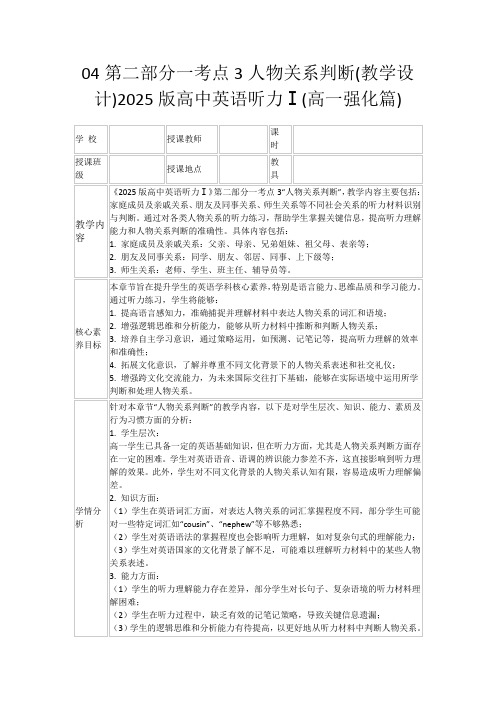
(2)影响课堂活动的开展,降低教学效果;
(3)影响学生自主学习能力的培养,制约听力能力的提高。
针对以上学情分析,教师应在教学中采取有针对性的措施,激发学生的学习兴趣,提高学生的听力能力,培养良好的学习习惯,从而提高课程教学效果。
教学方法与策略
为确保教学目标的有效实现,针对学生的特点和学习需求,本章节采用以下教学方法与策略:
问题:Who is visiting the speaker this weekend? What is the relationship between the speaker and Jack?
答案:Jack is visiting the speaker this weekend. They are cousins.
题目4:
听力材料:I met a new friend at the gym yesterday. Her name is Lisa. We both enjoy working out and chatting during breaks.
问题:Who did the speaker meet at the gym? What is their relationship?
学情分析
针对本章节“人物关系判断”的教学内容,以下是对学生层次、知识、能力、素质及行为习惯方面的分析:
1.学生层次:
高一学生已具备一定的英语基础知识,但在听力方面,尤其是人物关系判断方面存在一定的困难。学生对英语语音、语调的辨识能力参差不齐,这直接影响到听力理解的效果。此外,学生对不同文化背景的人物关系认知有限,容易造成听力理解偏差。
(二)课堂导入(预计用时:3分钟)
激发兴趣:
Relationship between the Subtropical Anticyclone and Diabatic Heating

᭧2004American Meteorological SocietyF IG.1.Monthly mean column-integrated total heating in(a)Jan in the southern subtropicsand(b)Jul in the northern subtropics.Units are W mϪ2.tropical anticyclones over the North Pacific and North Atlantic appear as‘‘triangular shaped,’’and their centers are biased to the east.Chen et al.(2001)interpreted such a‘‘tilting’’as a result of the meridional shear of the zonal wind.However the simulated anticyclone fol-lowing this line was presented as a parallelogram with its center biased westward,quite unlike the observa-tions.All of these imply that the synthetic diabatic ef-fects on the maintenance of the summertime subtropical anticyclone are still unclear.In this study,the reanalysis of the National Centers for Environment Prediction–National Center for At-mospheric Research(NCEP–NCAR;Kalnay et al.1996) from1980to1997and a climate model are employed to investigate the separated and synthetic impacts of different thermal forcings on the formation of the sum-mertime subtropical anticyclones.The diabatic heating in the reanalysis is not an observation,but the product of a GCM that depends on physical parameterization schemes(Newman et al.2000).Comparisons between the NCEP heating and Q1from European Centre for Medium-Range Weather Forecasts(ECMWF)data(Ni-gam et al.2000;Rodwell and Hoskins2001)and Trop-ical Ocean Global Atmosphere(TOGA)data(Lin and Johnson1996)show that both the horizontal distribution of the column-integrated heating and the vertical heating profile are similar.Duan(2003,personal communica-tion)also made comparisons between the NCEP–NCAR reanalysis and two other datasets.One is for observa-tions from July1993to March1999from six Automatic Weather Stations(AWSs)over the Tibetan Plateau(Li et al.2001).The other is the Global Energy and Water Cycle Experiment(GEWEX)Asian Monsoon Experi-ment(GAME)Intesive Observing Period(IOP)re-analysis from1April to31October1998completed by the Japan Meteorological Research Institute and the Ja-pan Meteorological Agency(unpublished).Results show that the surface sensible heatflux and latent heat flux provided by NCEP–NCAR agree with the AWS data,and there is no significant difference in the vari-ation and magnitude between the NCEP–NCAR and GAME-IOP daily datasets.This then validates the usage of the NCEP–NCAR reanalysis for the present study, although caution is required since both the AWS and GAME-IOP data have limited spatial and temporal cov-erage.Section2shows the observed distributions of the subtropical circulation against diabatic heating in July for the Northern Hemisphere and in January for the Southern Hemisphere.In section3,the relevant dynam-ics concerning the atmospheric responses to different kinds of heating are reviewed briefly,and the factors in generating the zonally asymmetric subtropical anticy-clones are explored.Numerical experiments are then designed in section4to compare with observations and to verify the hypothesis presented in section3.In section 5,all of these different kinds of forcings are put together to get their synthetic impacts on the formation of the summertime subtropical anticyclone.Conclusions and discussion are presented in section6.2.Diabatic heating and circulation in summersubtropicsa.Column-integrated total heating and surfacesensible heatingThe distributions of the column-integrated total dia-batic heating(TH)retrieved from the NCEP–NCAR re-analysis for January and July are presented in Fig.1. Along the summer subtropics,except in lower latitudes, heating is usually over land and cooling is over ocean. The distributions of the zonal deviation of geopotential height at different levels are shown in Fig.2.In both the Southern and Northern Hemispheres,the surface lows are located over the subtropical continents,with strong equatorwardflow existing along,and to the west of,the western coastal regions(Figs.2b and2d),where-as the surface subtropical anticyclone centers are located in the eastern parts of the oceans,with magnitudes of more than30gpm in the Southern Hemisphere and90 gpm in the Northern Hemisphere.At200hPa(Figs.2a and2c),the subtropical anticyclones are observed over continents,whereas troughs are located over oceans. The magnitude of the anticyclones in the SouthernF IG.2.Monthly mean distributions of the zonal deviation of the geopotential height(units are gpm)and of sensible heatflux at the surface(shading,units are W mϪ2)at(a),(c)200and(b), (d)1000hPa,for(a),(b)Jan and(c),(d)Jul.Hemisphere is more than30gpm.The North Americanhigh is more than60gpm,whereas the South Asianhigh is stronger than120gpm and spans a vast longi-tudinal domain in the subtropics ranging from NorthAfrica to the western Pacific.It is more than twice asstrong as its counterpart over North par-ing Fig.2to Fig.1,a prominent feature is then obtained:the positive TH over each subtropical continent in thesummer hemisphere is accompanied by the surface cy-clone and the upper-layer anticyclones,whereas the neg-ative TH over each subtropical ocean sector is accom-panied by the surface anticyclone and the upper-layercyclonic circulation.Such a coordination between THand the circulation pattern can be well understood byusing the potential vorticity–potential temperature(PV–)view proposed by Hoskins(1991);namely,heating (cooling)generates lower-layer cyclonic(anticyclonic)circulation and upper-layer anticyclonic(cyclonic)cir-culation.Therefore,as afirst approximation,the sum-mer subtropical circulation as presented in Fig.2canbe interpreted as the adaptation of atmospheric circu-lation to the diabatic heating(Wu and Liu2000)alongthe subtropics.The distributions along summer subtropics of the sur-face sensible heatflux are also shown in Fig.2.InJanuary in the Southern Hemisphere(Figs.2a and2b),it is more than100W mϪ2over Australia,and over thewestern coasts of South Africa and South America.InJuly in the northern subtropics(Figs.2c and2d),thearea of more than100W mϪ2covers western NorthAmerica,North Africa,and western and middle Asia.A prominent feature is then obtained:strong surface sensible heating(SE)exists over each subtropical con-tinent in the summer hemisphere,particularly over the western paring Fig.2with Fig.1,we see that except for the eastern part,the positive TH over the western and central parts of each continent in the summer subtropics mainly result from the in situ SE. In addition,the centers of either the surface cyclones or the upper-layer anticyclones over continents are lo-cated over the SE areas.All of these imply the signif-icance of the continental SE in the maintenance of the summertime subtropical circulations.b.Deep condensation heating(CO)The distributions in summer months of deep conden-sation heating(CO)and the associated zonal deviation winds in the upper and lower troposphere are presented in Fig.3.In January(Figs.3a and3b),the three sub-tropical heating regions are located,respectively,from eastern Africa to about80ЊE,from eastern Australia to 120ЊW,and from the eastern coast of Brazil to25ЊW. Strong CO along the western coast of South America is also observed due to the Andes.At850hPa(Fig. 3b),polewardflow dominates the region of convective heating except along the eastern coast of Australia where weak equatorwardflows exist due to the local orograph-ic forcing.The strong CO centers of more than250W mϪ2over Madagascar and along the eastern coast of Brazil in the subtropics and over the eastern side of the date line in the Tropics are all accompanied by poleward flows of more than4m sϪ1.Apparent subtropical cy-clone and anticyclone circulations are therefore ob-F IG.3.Monthly mean distributions of the zonal deviation wind(vector;units are m sϪ1)and of convective condensation heating(shading;units are W mϪ2)at(a),(c)200and(b),(d)850 hPa,for(a),(b)Jan and(c),(d)Jul.served,respectively,to the west and east of these strong CO centers.In the upper troposphere(Fig.3a),equa-torwardflow prevails over these regions of deep con-densation heating in the subtropics,and anticyclonic and cyclonic circulations are observed,respectively,to the west and east of these heating centers.In July(Figs.3c and3d),CO of more than50W mϪ2also exists over areas from the eastern continents to the western oceans along the subtropics.While the area of more than100W mϪ2over the western Atlantic is more confined to the coastal region,it appears over the whole western Pacific and extends beyond the date line.Strong CO of more than250W mϪ2is observed over the southeastern continental United States and east-ern China.As in the Southern Hemisphere,equatorward flow in the upper troposphere(Fig.3c)and poleward flow in the lower troposphere(Fig.3d)prevail over these two strong heating areas.Theflows are more pro-nounced and organized particularly over the Asian mon-soon area.As a result,prominent anticyclone circula-tions are found to the west of the strong CO regions in the upper troposphere,and to their east in the lower troposphere.c.Radiative coolingThe distributions in summer months of the column-integrated cooling(copied from Fig.1)and the asso-ciated zonal deviation winds in the upper and lowertroposphere are presented in Fig.4.Cooling covers theeastern oceans and the poleward side of the westernoceans in the subtropics.In particular,it is stronger than Ϫ100W mϪ2over the eastern coastal region of each ocean basin.The zonal deviation circulations,in asso-ciation with such cooling,bear common features overeach of thefive subtropical ocean basins;namely,thesurface anticyclonic and upper-layer cyclonic circula-tions appear in the cooling region over oceans,as dis-cussed in section2a and emphasized by Rodwell andHoskins(2001).Another remarkable feature revealed in Fig.4is that strong surface equatorwardflow and upper-layer polewardflow appear over the eastern offshore ocean region where radiative cooling becomes the main feature of the atmospheric heating.Such a relationship between the meridionalflow and radiative cooling can also be detected over the Mediterranean Sea.The only exception is observed along the western coastal regionF IG.4.Monthly mean distributions of the zonal deviation wind(vector;units are m sϪ1),and of column-integrated cooling(shading;units are W mϪ2)at(a),(c)200and(b),(d)1000hPa, for(a),(b)Jan and(c),(d)Jul.of the Arabian Sea,where southerlies develop in the lower troposphere due to the strong suction of the el-evated heating over the Tibetan Plateau in summer(Wu et al.1997a;Ye and Wu1998).3.Dynamics relevant to the maintenance of thesubtropical anticycloneAlthough the theory of the thermal adaptation of at-mospheric circulation to diabatic heating presented above can be used to explain the general distributions of the summertime subtropical anticyclone,it cannot explain the asymmetric configurations of the subtropical anticyclone in several detailed aspects.For instance, strong meridionalflows either in the upper or in the lower troposphere along the subtropics are usually as-sociated with strong condensation heating(Fig.3)or radiative cooling(Fig.4);the equatorwardflow in the region along,and to the west of,the western coast of each continent near the earth’s surface is much devel-oped;and the center of the surface anticyclone over ocean is biased eastward(Fig.2),etc.All these cannot be simply explained by the thermal adaptation theory.A theoretical study by Gill(1980)shows that the at-mospheric response to a heating source or sink located in low latitudes exhibits an asymmetric Rossby wave pattern.In the Northern Hemisphere,southwesterlies (northeasterlies)are generated to the east of the heating source(sink).Although this theory can be used to in-terpret the tilting of the subtropical anticyclones,it can-not explain the eastward bias of the surface subtropical anticyclone centers.To help understand these asymmetries,based on the NCEP–NCAR reanalysis,the July mean heating profiles at different locations along the ridgeline of the sub-tropical anticyclone in the Northern Hemisphere are pre-sent in Fig.5.Those in the southern subtropics are sim-ilar and are not shown here.To confirm the dominance of different types of heating in different locations,the vertical profiles of CO,SE,LO,and TH(including other types of heating)at typical sites are presented.Figure 5a is for the area based in the Western Hemisphere, whereas Fig.5b is for the area based in the Eastern Hemisphere.The four sites L(30ЊN,122ЊW),S(30ЊN, 108ЊW),C(30ЊN,80ЊW),and D(30ЊN,60ЊW)selected for plotting in Fig.5a and the four sites L(30ЊN,24ЊW),F IG.5.Vertical profiles of various Jul mean heating at sites L,S,C,and D as indicated in Figs.1b and13in the (a)western and(b)eastern Northern Hemisphere.Shown are longwave radiative cooling(LO,open square),diffusive sensible heating(SE,filed square),deep condensation heating(CO,open circle),and total heating(TH,cross,including all other heating).Units are K dayϪ1.S(30ЊN,0Њ),C(30ЊN,120ЊE),and D(30ЊN,145ЊE) selected for plotting in Fig.5b are located,respectively, within different heating lobes as marked in Fig.1b(and also in Fig.13).At the L sites(left panels)over the eastern Pacific and Atlantic,weak SE is near the surface,and no ap-parent CO is observed.Strong LO values ofϪ6.5K dayϪ1over the eastern Pacific and Atlantic appear in the lower layer between0.5and1.5km(ϳ0.85and0.95) above sea level.The profile of TH then follows the LO profile.These regions are therefore defined as the LO heating lobes.At the S sites(middle-left panels)over western North America(Fig.5a)and North Africa(Fig. 5b),CO is weak,and SE dominates the lower tropo-sphere with a maximum of about6K dayϪ1near the surface.The TH profile in these areas then follows the SE profile.These regions are therefore defined as the SE heating lobes.At the C sites(middle-right panels) along the eastern coasts of North America(Fig.5a)and China(Fig.5b),the thick CO with a maximum of about 4K dayϪ1in the upper troposphere is the main feature, and the TH profile follows the CO profile.These regionsF IG .6.Schematic diagram indicating the summertime subtropicalatmospheric response to the vertically differential diabatic forcing of (a)sensible heating,(b)deep condensation heating,and (c)longwave radiative cooling.Here,A denotes an anticyclone,C denotes a cy-clone,and the profiles at the centers of each panel indicate the dom-inating heating.are therefore defined as the CO heating lobes.At the D sites (right panels)over the western Atlantic (Fig.5a)and western Pacific (Fig.5b),CO is less than 2K day Ϫ1.The CO together with other types of heating (figure not shown)exceed the longwave radiative cooling in the layer between ϭ0.2and 0.6over the western Atlantic and are near ϭ0.2over the eastern Pacific,but are weaker than the cooling above and below these layers.Thus the in situ column-integrated TH is negative as shown in Fig.1,and the TH profile in these regions is determined mainly by the double-dominant heating (D),that is,LO and CO.These regions are therefore defined as the D heating lobes.The negative TH in lobe D contributes to the occurrence of the lower-(upper-)layer anticyclonic (cyclonic)circulation and distinguishes it from lobe CO,whereas the existence of the secondary dominant heating CO in this lobe results in the devel-opment of the lower-(upper-)layer poleward (equator-ward)flow wet climate and distinguishes the lobe from the LO lobe in which the climate is rather dry.Results from Fig.5show that the TH profiles vary from one location to the other,and follow the profiles of LO at L,SE at S,CO at C,and the double-dominant heating at D,respectively.They compose a LOSECOD heating quadruplet over each continent and its adjacent oceans (Wu and Liu 2003).Let us now consider how the vertical differential heat-ing can influence the atmospheric circulations.In the subtropics,particularly along the ridgeline of the sub-tropical anticyclone,both the vorticity advection and transient processes are weak (Wu et al.1999;Rodwell and Hoskins 2001;Liu et al.2001),and vorticity equa-tion can be simplified to the Sverdrup balance:Ϫ1ഠ(f ϩ)Q ( 0).z z z (1)This implies that in the absence of horizontal advec-tion and at a steady state,the increase (decrease)of the relative vorticity due to the vertical differential heating should be compensated for by the planetary vorticity (Q z )advection brought in through the meridional winds from low (high)latitudes.Therefore the thermally forced circulation along the subtropics depends strongly on the vertical profile of the heating.Since f is positive in the Northern Hemisphere but negative in the Southern Hemisphere,in a statically stable atmosphere (z Ͼ0)a heating that increases with altitude will generate pole-ward flow,whereas a heating that decreases with altitude will produce equatorward flow.This then provides an-other base for understanding the formation of the asym-metric configuration of the summertime subtropical an-ticyclone,and can be summarized below by the sche-matic diagrams presented in Fig.6.a.Surface sensible heatingDuring summer along the subtropics,the land surface sensible heat flux over the western continents usually exceeds 100W m Ϫ2,which amounts to a heating rate(Q )of 10Ϫ5K s Ϫ1.For a large-scale atmospheric system such as the subtropical anticyclone,the order of mag-nitude for z is estimated as O (z )ϳ10Ϫ2K m Ϫ1,and that for the forcing term on the right-hand side of (1)is estimated as 10Ϫ10s Ϫ2.Then the forced equatorward flow in the lower layers is estimated as 1–10m s Ϫ1.This means that,in response to a surface sensible heat flux of 100W m Ϫ2,the equatorward winds of several meters per second will be forced over the heating region in the lower layers with a thickness of about 1km (Fig.6a).Therefore equatorward flow on the western side of the surface cyclone should be stronger than the poleward flow on its eastern side,resulting in the westward bias of the cyclone center over the continent (Fig.2).The intensified equatorward flow along the western coast of the continent brings colder air and favors the enhance-ment of sensible heat release from the warm land sur-face.This then explains why the strongest sensible heat-ing in the summer subtropics appears along the western coast of each continent (Fig.2).b.Deep convective condensation heatingAlong the subtropics,maximum CO usually occurs at a height (z ϭZ M )between 300and 400hPa where the heating rate can be several degrees per day.This,following the thermal wind balance,results in a strong westerly to its north and an easterly to its south aboveT ABLE 1.Experiments of different external forcings (see text for detailed description).GCM exptsPerpetual Jul experiments SH-1SH-2CONSE alone SE ϩLOSE ϩLO ϩCO ϩorographySH-0P LH-0P LH-1P LH-2P SH-2P CON-PIdealized SH in an aquaplanet Idealized CO in an aquaplantet CO ϩLO in an aquaplanet CO ϩLO ϩorography SE ϩLO ϩorographySE ϩLO ϩCO ϩorographythe heating region.Thus,even in the upper troposphere in the subtropics,vorticity advection above a deep con-vection area is usually small.By using (1),the diabaticterm (f ϩ)Q z is estimated to be ϩ10Ϫ10s Ϫ2below Ϫ1z Z M ,but Ϫ10Ϫ9s Ϫ2above this level.Therefore a pole-ward flow of several meters per second is forced below Z M ,while a slightly stronger equatorward flow is forced in the upper troposphere.Such a mechanism then ex-plains why in Fig.3the equatorward flow in the upper troposphere and the poleward flow in the lower tropo-sphere are in accordance with the strong deep conden-sation heating in the subtropics.These forced strong meridional winds then contribute toward strengthening the formation of the subtropical anticyclone to the west of the deep convection region in the upper troposphere,and to its east in the lower troposphere,as schematically shown in Fig.6b and observed in Fig.3.c.Longwave radiative coolingThe maximum LO is usually below 850hPa with an intensity of about Ϫ6K day Ϫ1.Following a similar argument,such radiative cooling can produce a vorticity forcing of ϩ10Ϫ10s Ϫ2in the upper troposphere and Ϫ10Ϫ9s Ϫ2in the lower troposphere.Poleward flow of several meters per second in the upper layer and stronger equatorward flow in the lower troposphere are then forced.Such radiation-induced meridional flows rein-force those circulation patterns generated by sensible heating (Fig.6a)and favor the formation of the sub-tropical anticyclone to the west of the radiative cooling in the lower troposphere,but to its east in the upper troposphere,as shown in Fig.6c.We may therefore propose that the strong negative vorticity forcing near the surface due to LO over the eastern oceans contrib-utes to the eastward shift of the surface oceanic sub-tropical anticyclone,resulting in the asymmetric con-figuration of the surface subtropical anticyclones over oceans.4.Numerical experimentsTo verify further the atmospheric response to external thermal forcing,numerical experiments are designed by employing the Global Ocean–Atmosphere–Land Sys-tem (GOALS)model developed at the Institute of At-mospheric Physics/State Key Laboratory of Numerical Modeling for Atmospheric Sciences and Geophysical Fluid Dynamics (IAP/LASG;Wu et al.1997b;Zhang et al.2000;Table 1).Its atmospheric component is a spectral general circulation model that possesses nine vertical levels in coordinates and is rhomboidally trun-cated at wavenumber 15in the horizontal.The oceanic component is a gridpoint model with horizontal reso-lution of 4Њlatitude ϫ5Њlongitude and 20vertical layers (Zhang et al.1996).The land surface processes are rep-resented by the Simplified Simple Biosphere (SSiB)model (Xue et al.1991),which has been implemented in the atmospheric component (Liu and Wu 1997).The GOALS climate model can simulate the mean climate reasonably well and has been used in climate studies for different purposes (Houghton et al.2001;Kang et al.2002).In this study the ocean component of the model is switched off,and the required sea surface temperature (SST)and sea ice are prescribed by using the climate mean observation data of 1979–88developed for the Atmospheric Model Intercomparison Project (AMIP).Because the adjustment period measured by the global surface energy balance is about half a year for each experiment,all the experiments in this section are in-tegrated for 12model years,and the July means cal-culated from the last 10years are taken for comparisons.The normal integration is defined as a control run (CON)as shown in Table 1.A pair of GCM experiments (SH-1and SH-2)is designed to study the contributions of sensible heating and radiative cooling to the formation of the summertime subtropical anticyclones.Another group of sensitivity runs is also designed for the boreal summer as perpetual July experiments.In these runs,the solar zenith angle is fixed at the value corresponding to 15July,the SST assumes its zonal means,and the initial fields are taken from the July mean zonal states of the multiyear integration of the GOALS model.All the experiments are integrated for 24months,and the results from the last 12months are extracted for anal-ysis.To show the responses of the atmospheric circu-lation to a prescribed heating,only those zonal deviation fields are plotted.All the perpetual July experiments designed for the present study are also presented in Ta-ble 1and are described in detail in the following cor-responding sections.The distributions in CON of the July means are dem-onstrated in Fig.7.The simulated distribution of the surface sensible heat flux (shading)agrees in general with that of the NCEP–NCAR reanalysis (Figs.2c andF IG .7.Jul mean distributions in CON of the zonal deviation of geopotential height (units are gpm)and of the surface sensible heat flux (shading;units are W m Ϫ2)at (a)200and (b)1000hPa.F IG .8.Zonal deviation of geopotential height (units are gpm)at (a)500and (b)1000hPa,and (c)its vertical cross section at 30ЊN in the idealized perpetual Jul experiment SH-0P .The heavy curves in (a)and (b)bound the region where the heating is more than 1W m Ϫ2.Shading in (c)indicates the surface sensible heating region.2d),although the magnitude over eastern North America is too high.Surface cyclones and upper-layer anticy-clones are produced over continents,whereas surface anticyclones and upper-layer cyclones are located over oceans.Despite the coarse resolution of the model,it is able to produce the large-scale features of the subtrop-ical circulations.a.Idealized thermal forcing 1)S URFACESENSIBLE HEATINGPerpetual July and an aquaplanet are assumed for the experiment.To mimic the SE distributions over North America and over North Africa and the subtropical Asia,surface sensible heating is imposed in the two regions from 0Њto 105ЊE and from 90Њto 120ЊW ,and between 24.4Њand 46.6ЊN,with a heating maximum of 150W m Ϫ2lo-cated along the western boundaries and decreasing in sinusoidal form to zero along the eastern boundaries,as depicted in Fig.8c.The cloud distribution is prescribed as zonal symmetric and is obtained from CON.The model-induced condensation heating and sensible heat-ing are eliminated from the thermodynamic equation and are not allowed to warm the atmosphere.This ex-periment is labeled SH-0P .Figure 8shows that such SE produces anticyclone highs of 50gpm at 500hPa (Fig.8a)and strong surface lows of 80–100gpm over the two heating regions (Fig.8b).The two lows at 500hPa and the two surface highs of more than 40gpm are generated over the two ‘‘oceans’’between the two heat-ing areas.The vertical cross section along 30ЊN (Fig.8c)shows that the main atmospheric response over the heating region is the generation of cyclone circulation below 700hPa and anticyclone circulation above it,asF IG.9.Zonal deviation of horizontal wind(units are m sϪ1)at(a)200and(b)850hPa,and (c)the vertical cross section of the geopotential height at30ЊN(units are gpm)in the idealized perpetual Jul experiment LH-0P.The heavy curves bound the region where the heating is more than1K dayϪ1atϭ0.336.Shading indicates the vertical profile of the heating(units are K dayϪ1).is anticipated from the thermal adaptation theory.Inlower layers,strong northeries are generated over thewestern heating region(Fig.8b).It is important to notethat with the imposed surface sensible heating alone,the generated pattern of geopotential height deviationat1000hPa already captures the main features in theobservation(Fig.2d).This implies the importance ofland surface sensible heating in the formation of thesubtropical anticyclone in summer at least in the lowerlayers.2)D EEP CONVECTIVE CONDENSATION HEATING The strongest convective heating in July is observedover the northern Bay of Bengal.Following the NCEP–NCAR reanalysis,a localized deep convective conden-sation heating is prescribed over a region from6.7Њto33.3ЊN and from67.5Њto112.5ЊE in an aquaplanet.Amaximum heating center of8K dayϪ1is located at20ЊN,90ЊE where the basic zonalflow U vanishes at the height ϭ0.336(Fig.9c).The heating then decreases from the center outward in sinusoidal form to zero at theboundaries in both the longitudinal and meridional di-rections.This perpetual July experiment is labeled LH-0P.The results shown in Fig.9demonstrate that overthe heating region a southerly is forced at850hPa belowthe maximum heating(Fig.9b),whereas a northerly isforced at200hPa above the maximum heating(Fig.9a).Figure9c shows the vertical cross section of the zonaldeviation of geopotential height along30ЊN where the initial U is about4m sϪ1.Above the level of maximum heating,positive and negative geopotential heights are generated,respectively,to the west and east of the heat-ing;whereas below this level,the pattern is out of phase with that in the upper layer.These are the results an-ticipated from the Sverdrup balance(1),which are in good agreement with the observations presented in Fig.3.However,the anticyclone centers in both the upper and lower layers are too close to the heating(Fig.9c) compared to parison of Fig.9c with Fig.8c shows that over the heating region,the surface sensible heating tends to generate an out-of-phase ver-tical pattern of the geopotential height,whereas the deep convective heating tends to produce meridional winds in the free atmosphere subject to the Sverdrup relation (1)that was defined as a‘‘local mode’’by Chen(2001) and a surface cyclone in response to the heating.The main features presented in Fig.9c are also captured in the analytical solutions of Chen based on a linear qua-sigeostrophic model(QG)and under a5m sϪ1basic flow(his Fig.7e).However,two significant differences exist between the GCM and the linear QG outputs.First, the linear advection in the QG moves the local mode eastward,resulting in a striking out-of-phase vertical structure in streamfunction above the heating region. On the contrary,in the GCM as shown in Fig.9c,despite the existence in the initialfields of the basic westerly zonalflow(4m sϪ1)along30ЊN,such a local mode is over the heating region,just like the resting basicflow solutions in Chen(his Fig.7a).This is because in a。
维持人际关系稳定作文英语
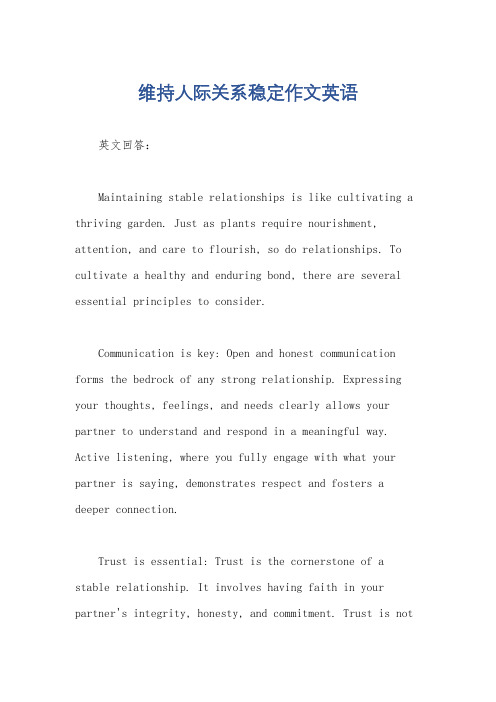
维持人际关系稳定作文英语英文回答:Maintaining stable relationships is like cultivating a thriving garden. Just as plants require nourishment, attention, and care to flourish, so do relationships. To cultivate a healthy and enduring bond, there are several essential principles to consider.Communication is key: Open and honest communication forms the bedrock of any strong relationship. Expressing your thoughts, feelings, and needs clearly allows your partner to understand and respond in a meaningful way. Active listening, where you fully engage with what your partner is saying, demonstrates respect and fosters a deeper connection.Trust is essential: Trust is the cornerstone of a stable relationship. It involves having faith in your partner's integrity, honesty, and commitment. Trust is notsomething that is automatically given; it must be earned through consistent actions and words that align with intentions. When trust is established, a sense of security and stability permeates the relationship.Respect boundaries: Relationships thrive when both partners respect each other's boundaries. This includes acknowledging their individual needs, preferences, and values. Setting clear boundaries ensures that each person's sense of self is honored and that conflicts are minimized.Compromise and flexibility: Life is filled with unforeseen challenges and obstacles. Maintaining stability in a relationship requires both partners to be willing to compromise and be flexible. Adapting to changing circumstances and finding mutually acceptable solutions strengthens the bond and fosters resilience.Support and encouragement: A stable relationship provides a sense of support and encouragement. Partners uplift each other through life's challenges and celebrations. Offering a listening ear, a shoulder to leanon, and encouragement for personal growth strengthens the connection and builds a foundation for mutual support.Forgiveness and understanding: Relationships are not without their conflicts and misunderstandings. When disagreements arise, it is essential to approach them with forgiveness and understanding. Holding grudges or carrying anger can damage the bond. Instead, seeking resolution through empathetic communication and a willingness toforgive allows for growth and reconciliation.Spending quality time together: Relationships are nourished by spending quality time together. This involves engaging in activities that foster connection, createshared experiences, and build memories. Whether it's a leisurely walk, a movie night, or a meaningful conversation, dedicating time to each other strengthens the bond.Appreciation and gratitude: Expressing appreciation and gratitude for your partner's presence and contributions strengthens the relationship. Recognizing their efforts, acknowledging their qualities, and showing them how muchyou care fosters a sense of value and belonging. Gratitude creates a positive cycle that reinforces the bond.Self-care and growth: While relationships are important, it is also essential to prioritize self-care and personal growth. Engaging in activities that bring you joy and fulfillment nurtures your well-being, which in turnbenefits the relationship. By investing in yourself, you bring a more positive, balanced, and resilient self to the partnership.Patience and understanding: Building a stable relationship takes time and effort. There will bechallenges and moments of doubt along the way. Patience and understanding are vital qualities that allow partners to navigate these difficulties together. Nurturing the bondwith unwavering support and a belief in its long-term potential fosters stability and resilience.中文回答:如何维持人际关系的稳定。
话题15 人际关系(Interpersonal relationships)
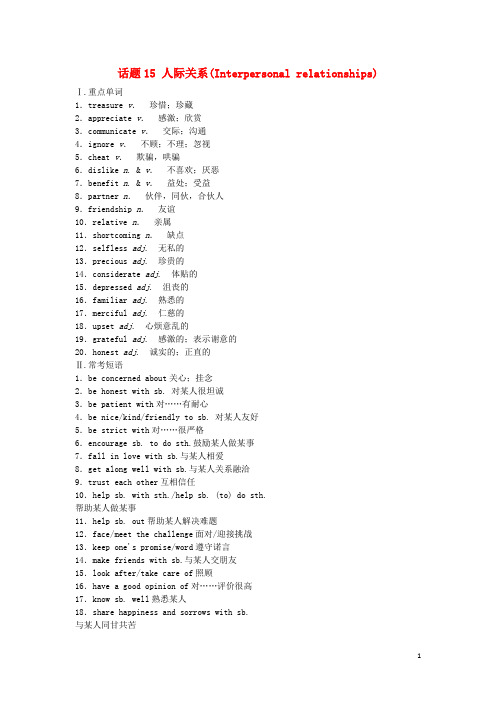
话题15 人际关系(Interpersonal relationships)Ⅰ.重点单词1.treasure v.珍惜;珍藏2.appreciate v.感激;欣赏3.communicate v.交际;沟通4.ignore v.不顾;不理;忽视5.cheat v.欺骗,哄骗6.dislike n. & v.不喜欢;厌恶7.benefit n. & v.益处;受益8.partner n.伙伴,同伙,合伙人9.friendship n.友谊10.relative n.亲属11.shortcoming n.缺点12.selfless adj. 无私的13.precious adj. 珍贵的14.considerate adj. 体贴的15.depressed adj. 沮丧的16.familiar adj. 熟悉的17.merciful adj. 仁慈的18.upset adj. 心烦意乱的19.grateful adj. 感激的;表示谢意的20.honest adj. 诚实的;正直的Ⅱ.常考短语1.be concerned about关心;挂念2.be honest with sb. 对某人很坦诚3.be patient with对……有耐心4.be nice/kind/friendly to sb. 对某人友好5.be strict with对……很严格6.encourage sb. to do sth.鼓励某人做某事7.fall in love with sb.与某人相爱8.get along well with sb.与某人关系融洽9.trust each other互相信任10.help sb. with sth./help sb. (to) do sth.帮助某人做某事11.help sb. out帮助某人解决难题12.face/meet the challenge面对/迎接挑战13.keep one's promise/word遵守诺言14.make friends with sb.与某人交朋友15.look after/take care of照顾16.have a good opinion of对……评价很高17.know sb. well熟悉某人18.share happiness and sorrows with sb.与某人同甘共苦19.turn to sb. for help向某人求助20.think highly/much of sb.对某人评价高Ⅲ.经典句式1.United we stand, divided we fall.团结则存,分裂则亡。
英语作文青春期人际关系
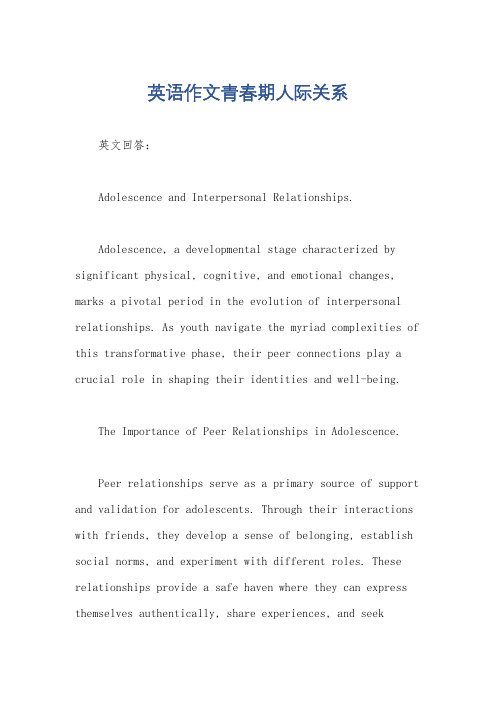
英语作文青春期人际关系英文回答:Adolescence and Interpersonal Relationships.Adolescence, a developmental stage characterized by significant physical, cognitive, and emotional changes, marks a pivotal period in the evolution of interpersonal relationships. As youth navigate the myriad complexities of this transformative phase, their peer connections play a crucial role in shaping their identities and well-being.The Importance of Peer Relationships in Adolescence.Peer relationships serve as a primary source of support and validation for adolescents. Through their interactions with friends, they develop a sense of belonging, establish social norms, and experiment with different roles. These relationships provide a safe haven where they can express themselves authentically, share experiences, and seekguidance.Types of Peer Relationships.Adolescents engage in various types of peer relationships, each offering unique benefits and challenges. Friendships, characterized by mutual support and trust,play a vital role in shaping self-esteem, empathy, andsocial skills. Romantic relationships, while providing intimacy and emotional closeness, can also lead tostressors such as jealousy and heartbreak. Acquaintances, individuals with whom adolescents have limited contact, serve as a source of information and social networking.Influence of Peer Relationships on Adolescent Development.Peer relationships exert a profound influence on adolescent development in several domains:Identity formation: Interactions with peers help adolescents define their values, beliefs, and interests,contributing to their sense of self.Socialization: Peers shape adolescents' social behaviors, attitudes, and norms, fostering their integration into society.Emotional regulation: Peer relationships provide opportunities for adolescents to practice empathy, resolve conflicts, and manage their emotions effectively.Academic achievement: Positive peer relationships can motivate adolescents to engage in academic pursuits and provide support for their educational endeavors.Challenges in Adolescent Peer Relationships.While peer relationships can be immensely beneficial, they also present challenges for adolescents. These may include:Peer pressure: Adolescents may experience pressure to conform to group norms, engage in risky behaviors, orostracize those who are different.Bullying: Peer bullying, whether physical, verbal, or online, can have devastating consequences for adolescent well-being.Social isolation: Some adolescents lack strong peer connections, leading to feelings of loneliness and alienation.Parental and School Roles in Supporting Healthy Peer Relationships.Parents and schools play a critical role in supporting healthy peer relationships among adolescents. Parents can foster open communication, encourage their children to engage in positive social activities, and provide guidance on navigating peer dynamics. Schools can create inclusive environments, offer peer support programs, and implement bullying prevention measures.Conclusion.Adolescent peer relationships are a complex and multifaceted phenomenon that plays a crucial role in shaping youth's development. Understanding the importance, types, and challenges associated with these relationships is essential for supporting adolescents as they navigate this transformative stage. Through collaboration between parents, schools, and adolescents themselves, we can foster healthy peer connections that promote positive outcomes in adolescence and beyond.中文回答:青春期的人际关系。
资本论第三卷英文
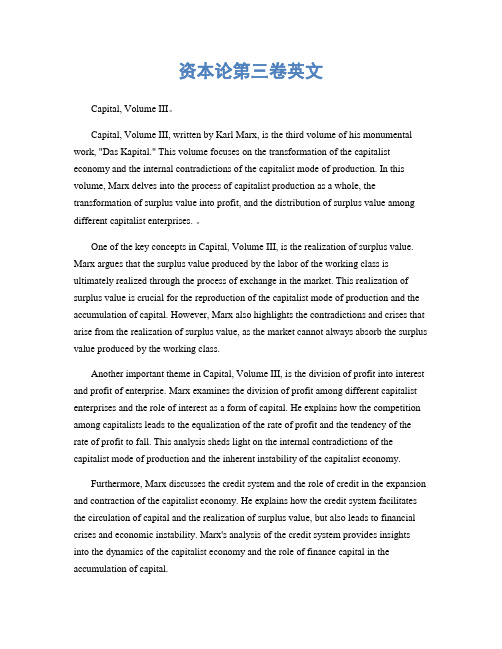
资本论第三卷英文Capital, Volume III。
Capital, Volume III, written by Karl Marx, is the third volume of his monumental work, "Das Kapital." This volume focuses on the transformation of the capitalist economy and the internal contradictions of the capitalist mode of production. In this volume, Marx delves into the process of capitalist production as a whole, the transformation of surplus value into profit, and the distribution of surplus value among different capitalist enterprises. 。
One of the key concepts in Capital, Volume III, is the realization of surplus value. Marx argues that the surplus value produced by the labor of the working class is ultimately realized through the process of exchange in the market. This realization of surplus value is crucial for the reproduction of the capitalist mode of production and the accumulation of capital. However, Marx also highlights the contradictions and crises that arise from the realization of surplus value, as the market cannot always absorb the surplus value produced by the working class.Another important theme in Capital, Volume III, is the division of profit into interest and profit of enterprise. Marx examines the division of profit among different capitalist enterprises and the role of interest as a form of capital. He explains how the competition among capitalists leads to the equalization of the rate of profit and the tendency of the rate of profit to fall. This analysis sheds light on the internal contradictions of the capitalist mode of production and the inherent instability of the capitalist economy.Furthermore, Marx discusses the credit system and the role of credit in the expansion and contraction of the capitalist economy. He explains how the credit system facilitates the circulation of capital and the realization of surplus value, but also leads to financial crises and economic instability. Marx's analysis of the credit system provides insights into the dynamics of the capitalist economy and the role of finance capital in the accumulation of capital.In addition, Capital, Volume III, explores the role of the state in the capitalist economy. Marx examines the relationship between the state and the capitalist class, and the state's role in regulating and stabilizing the capitalist economy. He argues that the state serves the interests of the capitalist class and plays a crucial role in maintaining the conditions for the accumulation of capital. Marx's analysis of the state provides a critical perspective on the political and economic power dynamics in capitalist societies.In conclusion, Capital, Volume III, is a comprehensive and in-depth analysis of the capitalist mode of production and the internal contradictions of the capitalist economy. Marx's analysis of the realization of surplus value, the division of profit, the credit system, and the role of the state provides a critical understanding of the dynamics of the capitalist economy. This volume continues to be a foundational text for the study of political economy and the critique of capitalism.。
关于relationship的文章 初中
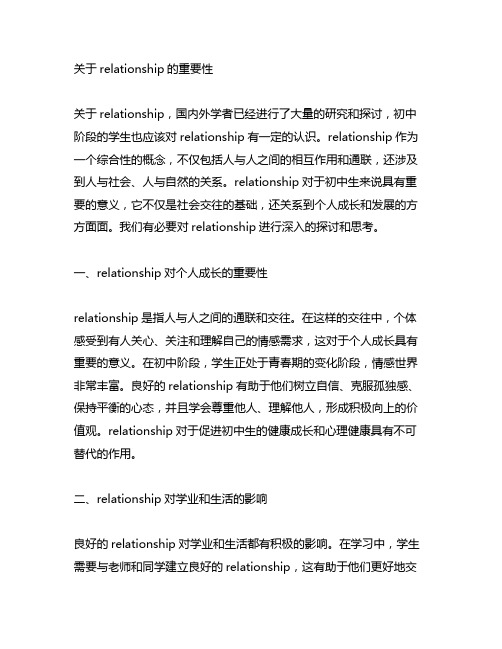
关于relationship的重要性关于relationship,国内外学者已经进行了大量的研究和探讨,初中阶段的学生也应该对relationship有一定的认识。
relationship作为一个综合性的概念,不仅包括人与人之间的相互作用和通联,还涉及到人与社会、人与自然的关系。
relationship对于初中生来说具有重要的意义,它不仅是社会交往的基础,还关系到个人成长和发展的方方面面。
我们有必要对relationship进行深入的探讨和思考。
一、relationship对个人成长的重要性relationship是指人与人之间的通联和交往。
在这样的交往中,个体感受到有人关心、关注和理解自己的情感需求,这对于个人成长具有重要的意义。
在初中阶段,学生正处于青春期的变化阶段,情感世界非常丰富。
良好的relationship有助于他们树立自信、克服孤独感、保持平衡的心态,并且学会尊重他人、理解他人,形成积极向上的价值观。
relationship对于促进初中生的健康成长和心理健康具有不可替代的作用。
二、relationship对学业和生活的影响良好的relationship对学业和生活都有积极的影响。
在学习中,学生需要与老师和同学建立良好的relationship,这有助于他们更好地交流、互相学习和取长补短。
良好的relationship也会给学生带来更多的正能量和支持,有助于他们在学习上更加努力和坚定。
在生活中,良好的relationship有助于学生建立自信、拓展人际关系,使他们更好地融入集体,积极面对生活中的挑战和困难。
三、relationship对社会的重要性relationship不仅关系到个人的成长和发展,还关系到社会的和谐和稳定。
良好的relationship有助于社会成员之间的相互信任、相互尊重和相互支持,使整个社会更具凝聚力和向心力。
在一个良好relationship的社会中,人们更关心他人的感受,更愿意助人为乐,形成积极的社会氛围和价值观,促进社会的和谐稳定。
讨论身心的关系英语作文
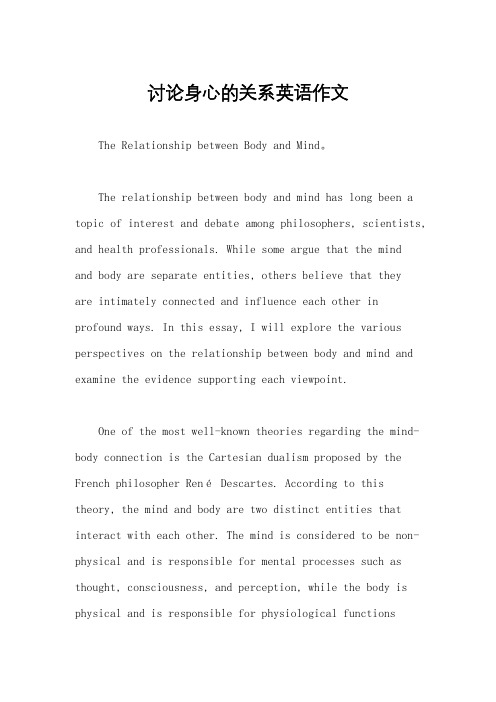
讨论身心的关系英语作文The Relationship between Body and Mind。
The relationship between body and mind has long been a topic of interest and debate among philosophers, scientists, and health professionals. While some argue that the mindand body are separate entities, others believe that theyare intimately connected and influence each other in profound ways. In this essay, I will explore the various perspectives on the relationship between body and mind and examine the evidence supporting each viewpoint.One of the most well-known theories regarding the mind-body connection is the Cartesian dualism proposed by the French philosopher René Descartes. According to this theory, the mind and body are two distinct entities that interact with each other. The mind is considered to be non-physical and is responsible for mental processes such as thought, consciousness, and perception, while the body is physical and is responsible for physiological functionssuch as movement, sensation, and digestion. Descartes believed that the mind and body interact through the pineal gland, a small structure in the brain that he believed was the seat of the soul.While the Cartesian dualism theory has been influential in shaping our understanding of the mind-body relationship, it has been criticized for oversimplifying the complex interactions between the mind and body. In contrast, the holistic approach to health and wellness emphasizes the interconnectedness of the mind, body, and spirit. This perspective views the body and mind as a unified system, with each part influencing and affecting the other. For example, stress and negative emotions can have physical effects on the body, such as increased heart rate and blood pressure, while physical activity can improve mental health by reducing stress and anxiety.Another theory that supports the idea of a mind-body connection is the psychoneuroimmunology (PNI) model. This model proposes that the immune system, nervous system, and endocrine system are all interconnected and thatpsychological factors such as stress, emotions, and beliefs can influence the functioning of these systems. For example, stress can weaken the immune system and make individuals more susceptible to illness, while positive emotions and beliefs can enhance immune function and promote healing.Recent research has also provided evidence for themind-body connection. Studies have shown that mindfulness meditation, which involves focusing one's attention on the present moment, can reduce stress, anxiety, and depression, as well as improve immune function and physical health. Similarly, cognitive-behavioral therapy (CBT), which helps individuals change negative thought patterns and behaviors, has been shown to be effective in treating a wide range of physical and mental health conditions, including chronic pain, irritable bowel syndrome, and anxiety disorders.In conclusion, the relationship between body and mindis complex and multifaceted, with various theories and perspectives offering different insights into this connection. While some argue that the mind and body are separate entities, others emphasize theirinterconnectedness and the ways in which they influence and affect each other. Regardless of one's perspective, it is clear that the mind and body are intimately linked and that understanding this relationship is essential for promoting health and wellness.。
英语作文青春期人际关系
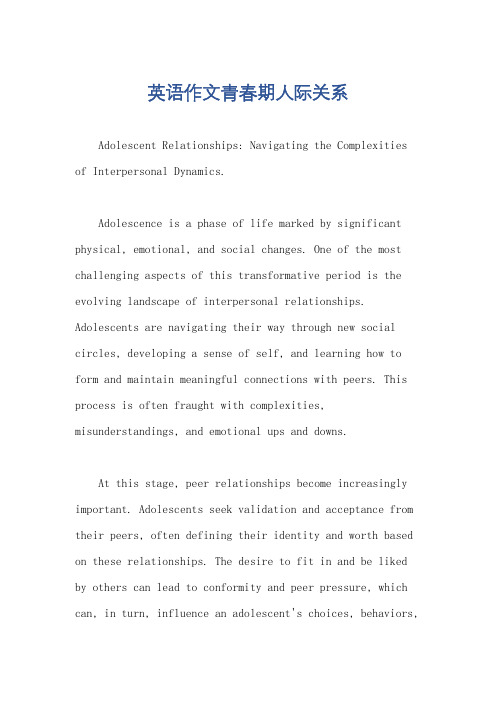
英语作文青春期人际关系Adolescent Relationships: Navigating the Complexities of Interpersonal Dynamics.Adolescence is a phase of life marked by significant physical, emotional, and social changes. One of the most challenging aspects of this transformative period is the evolving landscape of interpersonal relationships. Adolescents are navigating their way through new social circles, developing a sense of self, and learning how to form and maintain meaningful connections with peers. This process is often fraught with complexities, misunderstandings, and emotional ups and downs.At this stage, peer relationships become increasingly important. Adolescents seek validation and acceptance from their peers, often defining their identity and worth based on these relationships. The desire to fit in and be liked by others can lead to conformity and peer pressure, which can, in turn, influence an adolescent's choices, behaviors,and values.One of the key features of adolescent relationships is the formation of cliques or groups. These cliques can be based on shared interests, beliefs, or simply proximity. While cliques can provide a sense of belonging and support, they can also exclude others and foster a culture of exclusivity and judgment. Adolescents may find themselves caught between the pull of wanting to belong and the push of individuality and self-expression.Another significant aspect of adolescent relationships is the emergence of romantic relationships. The desire to explore and understand romantic love is a natural part of growing up. However, navigating romantic relationships can be challenging, especially given the emotional andcognitive immaturity of adolescents. The pressure to fit in and be accepted can lead to premature or unhealthy romantic attachments, which can have long-term effects on an adolescent's emotional well-being.The complexity of adolescent relationships is furthercompounded by the changing roles and dynamics within families. Adolescents are transitioning from childhood dependence to increased autonomy, which can lead to conflicts and misunderstandings with parents. Parents may struggle to understand their child's changing needs and behaviors, while adolescents may feel misunderstood and constrained by their parents' expectations.Despite these challenges, adolescent relationships provide an important opportunity for growth and learning. Through interactions with peers and romantic partners, adolescents learn about empathy, communication, conflict resolution, and the importance of boundaries and respect. These skills are crucial for healthy interpersonal relationships throughout life.To navigate the complexities of adolescent relationships, it is essential for adolescents to have access to support and guidance. Parents, teachers, and mentors can play a crucial role in providing a safe space for adolescents to express their feelings, thoughts, and challenges. By fostering open communication, understanding,and acceptance, these support systems can help adolescents develop healthy and fulfilling relationships.In conclusion, adolescent relationships are a dynamic and complex landscape marked by change, growth, and emotional ups and downs. By understanding the unique challenges and opportunities of this phase, adolescents, parents, and mentors can work together to foster healthy and supportive interpersonal relationships that promote positive development and well-being.。
Therelationshipbetweenateacherandastudent
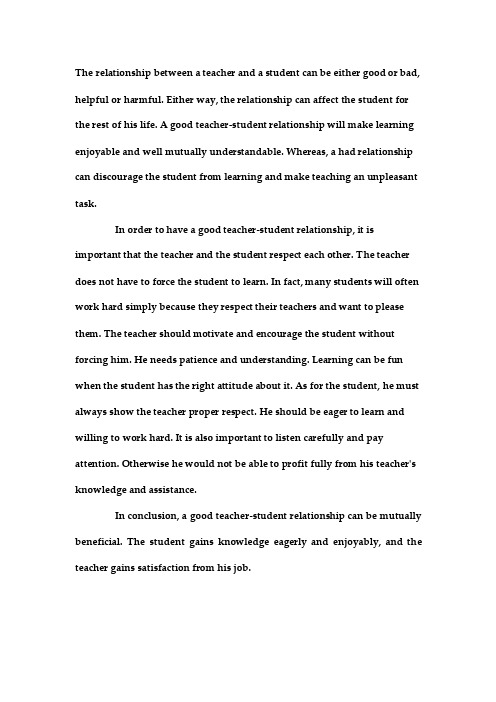
The relationship between a teacher and a student can be either good or bad, helpful or harmful. Either way, the relationship can affect the student for the rest of his life. A good teacher-student relationship will make learning enjoyable and well mutually understandable. Whereas, a had relationship can discourage the student from learning and make teaching an unpleasant task.In order to have a good teacher-student relationship, it is important that the teacher and the student respect each other. The teacher does not have to force the student to learn. In fact, many students will often work hard simply because they respect their teachers and want to please them. The teacher should motivate and encourage the student without forcing him. He needs patience and understanding. Learning can be fun when the student has the right attitude about it. As for the student, he must always show the teacher proper respect. He should be eager to learn and willing to work hard. It is also important to listen carefully and pay attention. Otherwise he would not be able to profit fully from his teacher's knowledge and assistance.In conclusion, a good teacher-student relationship can be mutually beneficial. The student gains knowledge eagerly and enjoyably, and the teacher gains satisfaction from his job.A good teacher-student relationship will make learning enjoyable and interesting for the students and teaching worth-while for a teacher.To set up a good teacher-student relationship, a teacher's behaviour is important. The teacher should motivate the students so that they want to learn. A good teacher should be patient, friendly and strict. Remember not to encourage the students by pushing or forcing them. Being too friendly may cause students to become lazy and stop working hard. On the other hand, being too strict may frighten the students. So a teacher should avoid going extremes in treating his students. And teachers should encourage the students to think independently and learn to study by themselves.As for the students, they must always respect their teachers. Students should be eager to learn and willing to work hard. It's important to listen with attention in class and it's more important to learn to raise questions and work out problems in new ways.In conclusion, a good teacher-student relation-ship can be mutually beneficial. The students gain knowledge eagerly and enjoyably and the teacher gains satisfaction from his job.5,Full imagination of "0"Possible version:"0" is like the sun which is rising in the east. The sun shines brightly, which makes our motherland warm and beautiful. "0" is like the globe which our geography teacher often uses in class. He tells us we can travel all over the world and enjoy the beauty."0" is like the football. Our football team packed into the World Cup and our 44-year hope came true. This year, we have already gained many achievements in sports, especially Li Xiaopeng, who has made a great breakthrough in the Olympic event."0" is like the moon of mid-autumn night. On the night, every family reunite and spend the night together. We expect that Taiwan returns to our motherland and we believe that the reunion of our country will come true, which is the greatest hope of all the Chinese people.。
relationship_between_traffic_flow_and_safety_of_freeways_in_china
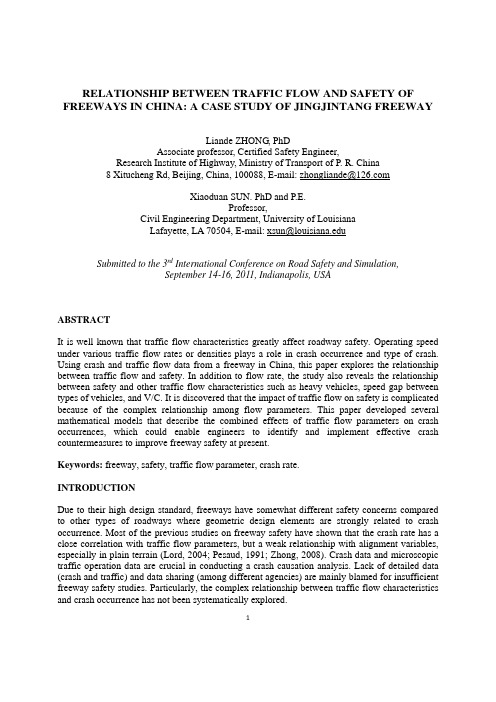
RELATIONSHIP BETWEEN TRAFFIC FLOW AND SAFETY OF FREEWAYS IN CHINA: A CASE STUDY OF JINGJINTANG FREEWAYLiande ZHONG, PhDAssociate professor, Certified Safety Engineer,Research Institute of Highway, Ministry of Transport of P. R. China8 Xitucheng Rd, Beijing, China, 100088, E-mail: zhongliande@Xiaoduan SUN. PhD and P.E.Professor,Civil Engineering Department, University of LouisianaLafayette, LA 70504, E-mail: xsun@Submitted to the 3rd International Conference on Road Safety and Simulation,September 14-16, 2011, Indianapolis, USAABSTRACTIt is well known that traffic flow characteristics greatly affect roadway safety. Operating speed under various traffic flow rates or densities plays a role in crash occurrence and type of crash. Using crash and traffic flow data from a freeway in China, this paper explores the relationship between traffic flow and safety. In addition to flow rate, the study also reveals the relationship between safety and other traffic flow characteristics such as heavy vehicles, speed gap between types of vehicles, and V/C. It is discovered that the impact of traffic flow on safety is complicated because of the complex relationship among flow parameters. This paper developed several mathematical models that describe the combined effects of traffic flow parameters on crash occurrences, which could enable engineers to identify and implement effective crash countermeasures to improve freeway safety at present.Keywords: freeway, safety, traffic flow parameter, crash rate.INTRODUCTIONDue to their high design standard, freeways have somewhat different safety concerns compared to other types of roadways where geometric design elements are strongly related to crash occurrence. Most of the previous studies on freeway safety have shown that the crash rate has a close correlation with traffic flow parameters, but a weak relationship with alignment variables, especially in plain terrain (Lord, 2004; Pesaud, 1991; Zhong, 2008). Crash data and microscopic traffic operation data are crucial in conducting a crash causation analysis. Lack of detailed data (crash and traffic) and data sharing (among different agencies) are mainly blamed for insufficient freeway safety studies. Particularly, the complex relationship between traffic flow characteristics and crash occurrence has not been systematically explored.1Roadway crashes occur when the four elements of a roadway system, drivers, vehicles, road alignment and environment, do not act together logically and consistently. Being the only active member of the system, drivers’ safety behavior is largely affected by prevailing traffic characteristics. This paper thoroughly investigates the intrinsic relationship between traffic flow and roadway safety on freeways. The results of the study could shed light on better crash countermeasures through traffic operation and management.DATAThe information used for this study was from one section of Jingjintang Freeway, which includes crashes, traffic characteristics and geometric design. This section of 4-lane freeway was built on a plain terrain with consistently high design standards such as large radius (the minimum is 5500 meters) and small grade (the maximum is 2.5%). Because of its function (connecting the capital and the major port), this freeway carries a heavy volume and experiences high crash frequencies. There are prominent differences in hourly flow rate and vehicular composition throughout the day. While cars dominate traffic during the day, and the night time traffic mainly consists of heavy vehicles.The traffic flow data were obtained from the control center of Jingjintang Freeway, derived from loop detectors at 9 locations of the Beijing section. The crash data was collected from the Department of Accidents of Traffic Management Bureau of Beijing. Traffic flow data was collected at one minute intervals, as well as the flow measurements including average vehicle counts, average speed, and lane detector occupancy. In this study, vehicles were divided into two types: small vehicles and trucks. Small vehicles include passenger cars, small vans and light trucks. Trucks are designated for all medium and large vehicles as well as trailers. Table 1 liststhe definitions of vehicle types.Table 1Vehicle Classification by “Technical Standard of Highway Engineering in China”Types Description Cars passenger cars with seats not more than 19 or trucks with loads not heavier than 2 tonsMedium vehicle passenger vehicles with seats more than 19 or trucks with loads between 2 and 7 tonsLarge vehicle Trucks with loads between 7 and 14 tonsTrailer Trucks with loads heavier than 14 tonsThere were a total of 1985 crashes during 2002, 2003 and 2004 in the Beijing section, including 638 property damage only accidents, 1299 injury accidents and 48 fatality accidents. There were 1244 accidents on the freeway’s Beijing-bound direction, 719 accidents in the opposite direction, and missing directional information on 11 crash records. To ensure the accuracy of the results, the study considered the directional analysis units (crashes and flow conditions). Furthermore, basedon interchanges and loop detector locations, the Beijing section was divided into 4 segments with regards to the existence of entrance and exit ramps, which experience different volumes and vehicle composition.23With the raw traffic data in one-minute intervals, average speed, traffic volume and proportions of small vehicles and trucks within one hour were estimated and used in the analysis. The crashes were also combined into one-hour intervals accordingly. Thus, the traffic parameters are paired with crashes on an hourly basis, which enables further analysis in this study. This type of analysis is feasible only if traffic flow characteristics are similar in different cross sections. Fortunately, such similarity has been proved (Chen, 2008). The crash rate is expressed as the number of hourly crashes per million vehicle kilometers traveled per year.ANALYSIS AND DISCUSSIONCorrelation Analysis and Descriptive StatisticsCrash occurrences are the result of many factors, and the relationship among these factors are complex, thus, independent variables should be carefully chosen to ensure their close correlation with the dependent variable and no or little correlation among themselves. For that purpose, the variables descriptive statistics and correlation analysis were done. As shown in Table 2, the crash rate is the dependent variable and 8 traffic flow parameters are the independent variables. Correlation coefficients vary between -1 and +1. The greater absolute value, the stronger the correlation.Table 2 Coefficient of correlation analysisTrucks speed Small vehicles speed Truck volume Small vehicles volumeTotal volume Speed difference Truck percentage V/C Crash rate Trucks speed 1.000Small vehicles speed0.833 1.000 Truck volume -0.646 -0.416 1.000Small vehicles volume0.001 -0.403 -0.197 1.000 Total volume -0.079 -0.462 -0.077 0.993 1.000Speed difference0.074 0.613 0.173 -0.728 -0.719 1.000 Truck percentage -0.423 -0.130 0.399 -0.769 -0.733 0.371 1.000 V/C-0.178 -0.525 0.076 0.962 0.988 -0.693 -0.672 1.000 Crash rate 0.149 0.302 -0.149 -0.452 -0.478 0.332 0.436 -0.501 1.000From the last line of Table 2, it is clear the biggest correlation coefficient (absolute value) is between flow saturation (V/C) and crash rate. The total flow, small vehicle volume, truck percentage as well as the average speed difference between small vehicles and trucks also have relatively close association with crash rate. Since the volume is used in computing crash rate in a linear form, only one variable related to traffic flow could be selected. Based on the correlation4coefficient analysis, three independent variables are chosen for the model, i.e., speed difference, truck percentage, and V/C. A data file was created and the descriptive statistical results of independent and dependent variables are shown in Table 3.Table 3 Result of descriptive statisticsSpeed difference Trucks percentage V/C Crash rate Mean18.173 0.380 0.293 1.290 Std. error0.365 0.019 0.012 0.057 Median19.020 0.272 0.258 1.127 Std. deviation5.061 0.263 0.164 0.792 Variance25.618 0.069 0.027 0.627 Skewness 0.547 -1.140 0.947 5.175Kurtosis-0.954 0.564 1.191 1.728 Range24.327 0.865 0.748 5.081 Minimum2.563 0.040 0.077 0.136 Maximum 26.890 0.904 0.825 5.217As shown in Table 3, the average speed difference is 18.2 km/h and the maximum is 26.9 km/h. It has been widely recognized that speed gap between small and large vehicles greatly affects roadway safety. It also can be seen that the 24-hour distribution of traffic composition is uneven, in the daytime, especially the peak hour, cars make the majority, and at night, especially after midnight, trucks primarily dominate the roadway.Combined Effects of Traffic Data on Crash RateNumerous studies establishing statistical links between a single traffic flow parameter and crash occurrence may be found in the literature (e.g. Zhong 2006 and 2007; Golob, 2004). However, these relationships can only be established under certain conditions to some extent. Combined effects of several traffic parameters on crash rate could better explain changes of traffic flow on the safety, which could provide more valuable information in decision-makings for traffic control strategies. Based on the data, the effects of any two variables from variables of speed difference, V/C, and truck percentage were demonstrated in a 3-D setting, as shown in Figures 1, 2 and 3.5Figure 1 Crash rate vs. V/C and Speed differenceFigure 2 Crash rate vs. Truck percentage and Speed differenceFigure 3 Crash rate vs. V/C and Truck percentage6The results from the three figures above clearly illustrate the great fluctuation of crash rate by speed difference, truck percentage and V/C. The minimum crash rate is 0.14, and the maximum is5.22. Lower crash rates appear when V/C values are between 0.6 and 0.75, the speed differences are between 6 and 9 km/h, and the percentage of trucks is less than 15%. While higher crash rates occur when V/C values are between 0 and 0.2, the speed differences are between 20 and 27 km/h, and the percentage of trucks are between 75% and 90% of the total traffic.The impact of a single variable varies depends on the values of other two variables. For example, the relationship between truck percentage and crash rate are different due to different levels of traffic flow. Although crash rate is positively related to percentage of trucks, under a steady flow condition (LOS B and C), crash rate increases insignificantly as trucks percentage increases. However, under free-flow condition (V/C<0.15), the crash rate increases rapidly as the percentage of trucks increases and reaches the maximum when the truck percentage reaches 90%.Modeling ResultsAs presented in the above section, there is a complex relationship among crash rate and three selected independent variables. The general linear and nonlinear regression models are not suitable for modeling these complicated relationships. Thus, a multivariate ratio of polynomials method was used by a prior study to establish the mathematical function of traffic flow data and crash rate (Garber, 1991). The multivariate ratio of polynomial procedure is a heuristic process, which searches for the best model to fit the data through hundreds of potential curves. The models developed through this process offer a larger variety of surfaces than the usual polynomial models; however, care must be taken not to use the model outside of the range of the data. In addition, the model should be studied graphically to determine that the model behaves as expected between data points.This study developed models using the Number Cruncher Statistical Systems (NCSS) software. Both the dependent and independent variables are transformed in 7 forms into the function for searching: )ln(,/1,,/1,/1,,22X X X X X X X . Since there is no direct 2R value for non-linear regression, a pseudo 2R value is used by NCSS. This value is defined by the following form:()()()()22222∑∑∑∑−−=i i i p y y y y R )) (1)Where:i y ˆ: model estimates y : mean of the observationsi y : actual observations7The 2R p value is used in the same manner as in a multiple regression, with values closer to 1.0 indicating more explanatory power in the model. Although the value does not have the same definition in traditional sense, it serves well for comparative purposes.To exploit the combined effects of traffic flow variables on crash rate, speed difference, truck percentage and V/C were again used as independent variables with the crash rate as the dependent variable. Multiple functions were obtained with multivariate ratio of polynomials method considering different variable forms. The process of goodness-of-fit comparison between functions was omitted in this paper. The final the optimal function selected to study the relationship between traffic flow variables and crash rate is listed below.SQRT(CR)=(1.813417)-(3.890536E-04)*(Spe_differ*Spe_differ)+(8.85468E-07)*(Spe_differ*Spe_dif fer)^2-(15.58812)*Truck_Per+(7.466595E-02)*(Spe_differ*Spe_differ)*Truck_Per-(1.456214E-04)*(Spe_differ*Spe_differ)^2*Truck_Per+(38.66152)*Truck_Per^2-(.1738746)*(Spe_differ*Spe_differ)*Truck_Per^2+(2.359875E-04)*(Spe_differ*Spe_differ)^2*Truck_Per^2+(2.346613)*(LN(VC_Ratio))-(2.113333E-04)*(Spe_differ*Spe_differ)*(LN(VC_R atio))-(1.177809E-05)*(Spe_differ*Spe_differ)^2*(LN(VC_Ratio))-(26.17044)*Truck_Pe r*(LN(VC_Ratio))+(9.667372E-02)*(Spe_differ*Spe_differ)*Truck_Per*(LN(VC_Ratio))-(1.3658E-04)*(Spe_differ*Spe_differ)^2*Truck_Per*(LN(VC_Ratio))+(54.67259)*Truck _Per^2*(LN(VC_Ratio))-(.2231054)*(Spe_differ*Spe_differ)*Truck_Per^2*(LN(VC_Rati o))+(2.679846E-04)*(Spe_differ*Spe_differ)^2*Truck_Per^2*(LN(VC_Ratio))+(1.252421)*(LN(VC_Ratio))^2-(4.01137E-04)*(Spe_differ*Spe_differ)*(LN(VC_Ratio))^2-(7.661727E-06)*(Spe_differ*Spe_differ)^2*(LN(VC_Ratio))^2-(10.1993)*Truck_Per*(LN(VC_R atio))^2+(3.020683E-02)*(Spe_differ*Spe_differ)*Truck_Per*(LN(VC_Ratio))^2-(2.297444E-05)*(Spe_differ*Spe_differ)^2*Truck_Per*(LN(VC_Ratio))^2+(18.68738)*Truck_P er^2*(LN(VC_Ratio))^2-(6.816921E-02)*(Spe_differ*Spe_differ)*Truck_Per^2*(LN(VC_Ratio))^2+(6.603523E-05)*(Spe_differ*Spe_differ)^2*Truck_Per^2*(LN(VC_Ratio))^2(2)Where:CR : crash rateSpe_differ : average operation speed difference between small vehicles and trucksTruck_Per : truck percentage of trafficVC_Ratio : traffic saturation (V/C)It can be seen from the regression function (2), a total of 3 independent variables and 26 coefficients are included. The left side of the function is the crash rate in the square root form, which could avoid the impossible situation that the crash rate acquires a negative value. In the process of searching for the optimal function, the independent variables are transformed into different forms, such as speed difference takes the square form, V/C adopts the logarithmic form, and truck percentage remains in the original form. The 511795.0=2R p , and by analyzing residual plots of crash rate corresponding to different variables shows the crash rate relatively scattered8when the speed difference is larger and V/C is small.According to function (2) the crash rate can be computed with the different traffic variables, and the combined effects of traffic flow on safety could be further analyzed. Figure 4, 5 and 6 are the 3-D diagrams depicting the impact of two variables on crash rate. It should be noted that these surface plots do not make use of actual data, but are obtained according to the model functional form with one variable fixed at its average value. This presentation is different from the 3-D charts in Figure 1 to Figure 3.Figure 4 Crash rate vs. V/C and Truck percentage (Speed difference=18.17 km/h)Figure 5 Crash rate vs. V/C and Speed difference (Trucks percentage=38%)9Figure 6 Crash rate vs. Truck percentage and Speed difference (V/C=0.29)Figure 4, 5 and 6 provide the more detailed explanation. Two of the three traffic flow variables, speed difference, truck percentage and V/C, make a complicated impact on crash rate when the third variable is fixed at its average value. Just as shown in the relationship function, the influence of a single variable on the crash rate varies as one or the other two variables change.Based on results shown in Figure 6, further analysis was done to illustrate the impact of speed difference. When V/C is at the mean (0.29) and truck percentage is 0%, the relationship between speed difference and crash rate is shown in Figure 7. It can be seen when speed difference is less than 15 km/h, the crash rate is little affected by speed difference, and it remains in a constant state, and when speed difference exceeds 15 km/h and continues to grow, then the crash rate increases by a faster rate.10Figure 7 Crash rate vs. Speed difference (V/C=0.29, Truck percentage=0%)Another relationship between speed difference and crash rate is shown in Figure 8, in which V/C is still 0.29 (unchanged), and trucks make up 90% of the total traffic volume. It is clear that Figure 8 is completely different from Figure 7, although both show the relationship of crash rate versus speed difference. Figure 8 reveals that the crash rate declines with increasing speed difference at first, when the speed difference reaches about 24 km/h the crash rate adopts the lowest value, then as speed difference continues to increase, the crash rate begins to soar.Figure 8 Crash rate vs. Speed difference (V/C=0.29, Truck percentage=90%)FINAL WORDSThe relationship between traffic flow and safety of freeways in China was studied with the data from Jingjintang Freeway. The results prove that the speed difference, truck percentage and V/C have strong association with crash rate. This paper described the combined effects of traffic flow variables on safety from multiple perspectives. Although the model established with multivariate ratio of polynomials method is complicated and the physical effects of variables are ambiguous, several valuable conclusions are drawn. Due to the interaction among independent variables, more potential parameters contributing to highway crashes should be considered in modeling, and when a specified relationship between single parameter and crash rate is introduced, other variables’ background should be clearly stated, otherwise the conclusions are meaningless.The correctness and applicability of the findings depends on the sample size and representativeness of the data. The microscopic traffic flow data used in this study are generally difficult to obtain. This paper used the data from only one freeway as a case study to illustrate a causation analysis between traffic flow and safety, therefore, the accuracy of the function needs further validation and calibration.ACKNOWLEDGEMENTSThis research was supported in part by grants from the National Science Foundation of China (Grant No. 50908106)and National Science and Technology Support Program (Grant No. 2009BAG13A03). The contents of this paper reflect the views of the authors who are responsible for the facts and the accuracy of the data presented herein. The contents do not necessarily reflect the official views or policies of the sponsors.REFERENCEChen Y. S., Sun X. D. and Zhong L. D. (2008). Speed Difference and Its Impact on Traffic Safety of One Freeway in China. Transportation Research Record, 2038:105-110.Garber, N. J. and Ehrhart, A. A. (1991). Final Report: The effect of speed, flow, and geometric characteristics on crash rates for different types of Virginia highways. Virginia Transportation Research Council, Charlottesville, Virginia.Golob, T. F. and Recker, W. W. (2004). A method for relating type of crash to traffic flow characteristics on urban freeways. Transportation Research Part A, 38(1): 53-80.Lord, D., Manar, A., Vizioli, A. (2004). Modeling Crash-Flow-Density and Crash-Flow-V/C Ration Relationships for Rural and Urban Freeway Segments. Presented at the 83rd Annual Meeting of the Transportation Research Board, Washington, D.C.Persaud, B N. (1991). Estimating accident potential of Ontario road sections. Transportation Research Record, 1327: 47-53.Zhong L. D. et al (2006). Exploring the Relationships between Crash Rates and Average Speed Differentia between Cars and Large Vehicles on a Suburban Freeway. Proceedings of IEEE ITSC 2006, September 17-20, Toronto, Canada.Zhong L. D. et al (2007). Research on the Relationship between V/C and Crash Rate on Freeway. Journal of Beijing University of Technology, 33(1): 37-40.Zhong L. D. (2008). Research on traffic accident prediction model for freeway. Beijing: College of Architecture and Civil Engineering, Beijing University of Technology.11。
The Power of Positive Relationships
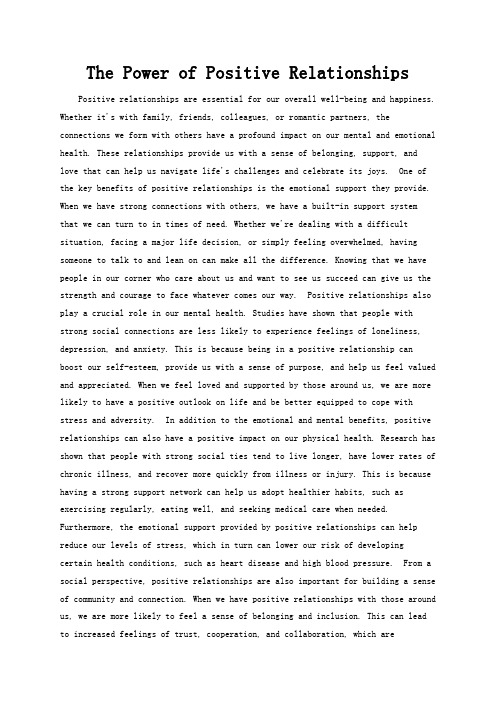
The Power of Positive RelationshipsPositive relationships are essential for our overall well-being and happiness. Whether it's with family, friends, colleagues, or romantic partners, the connections we form with others have a profound impact on our mental and emotional health. These relationships provide us with a sense of belonging, support, and love that can help us navigate life's challenges and celebrate its joys. One of the key benefits of positive relationships is the emotional support they provide. When we have strong connections with others, we have a built-in support systemthat we can turn to in times of need. Whether we're dealing with a difficult situation, facing a major life decision, or simply feeling overwhelmed, having someone to talk to and lean on can make all the difference. Knowing that we have people in our corner who care about us and want to see us succeed can give us the strength and courage to face whatever comes our way. Positive relationships also play a crucial role in our mental health. Studies have shown that people with strong social connections are less likely to experience feelings of loneliness, depression, and anxiety. This is because being in a positive relationship can boost our self-esteem, provide us with a sense of purpose, and help us feel valued and appreciated. When we feel loved and supported by those around us, we are more likely to have a positive outlook on life and be better equipped to cope with stress and adversity. In addition to the emotional and mental benefits, positive relationships can also have a positive impact on our physical health. Research has shown that people with strong social ties tend to live longer, have lower rates of chronic illness, and recover more quickly from illness or injury. This is because having a strong support network can help us adopt healthier habits, such as exercising regularly, eating well, and seeking medical care when needed. Furthermore, the emotional support provided by positive relationships can help reduce our levels of stress, which in turn can lower our risk of developingcertain health conditions, such as heart disease and high blood pressure. From a social perspective, positive relationships are also important for building a sense of community and connection. When we have positive relationships with those around us, we are more likely to feel a sense of belonging and inclusion. This can lead to increased feelings of trust, cooperation, and collaboration, which areessential for creating a harmonious and supportive social environment. Positive relationships can also help us develop empathy, compassion, and understanding for others, which can lead to a more tolerant and accepting society. It's importantto note that positive relationships require effort and investment from all parties involved. Building and maintaining strong connections with others takes time, communication, and mutual respect. It's important to listen actively, show empathy, and be willing to compromise and work through conflicts together. By nurturing our relationships and prioritizing the needs and feelings of those we care about, we can cultivate a sense of trust, intimacy, and connection that can enrich our lives in countless ways. In conclusion, the power of positive relationships cannot be overstated. From emotional and mental health benefits to physical well-being and social cohesion, the connections we form with others have a profound impact on our overall quality of life. By investing in our relationships, fostering open communication, and showing care and compassion for those around us, we can createa supportive and nurturing environment that allows us to thrive and flourish. Solet's cherish and nurture the positive relationships in our lives, for they are truly the cornerstone of our happiness and well-being.。
高二英语下学期期末考试试题_1 39
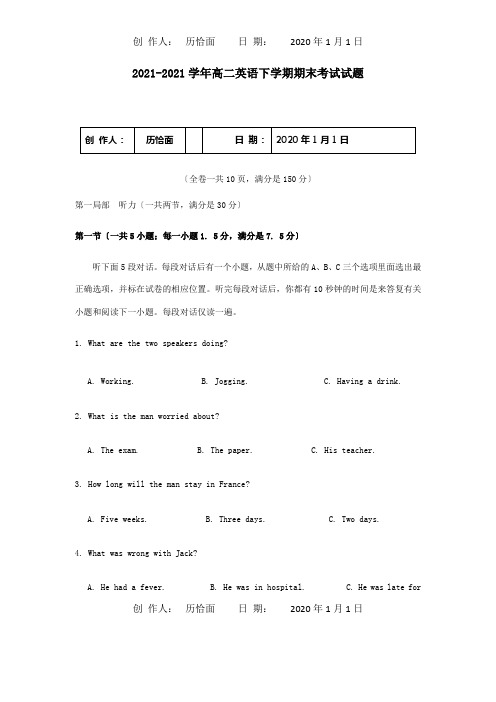
2021-2021学年高二英语下学期期末考试试题〔全卷一共10页,满分是150分〕第一局部听力〔一共两节,满分是30分〕第一节〔一共5小题;每一小题1. 5分,满分是7. 5分〕听下面5段对话。
每段对话后有一个小题,从题中所给的A、B、C三个选项里面选出最正确选项,并标在试卷的相应位置。
听完每段对话后,你都有10秒钟的时间是来答复有关小题和阅读下一小题。
每段对话仅读一遍。
1. What are the two speakers doing?A. Working.B. Jogging.C. Having a drink.2. What is the man worried about?A. The exam.B. The paper.C. His teacher.3. How long will the man stay in France?A. Five weeks.B. Three days.C. Two days.4. What was wrong with Jack?A. He had a fever.B. He was in hospital.C. He was late for创作人:历恰面日期:2020年1月1日work.5. Why was the man late for work?A. He was in an accident.B. His car was being repaired.C. He couldn’t get his car going.第二节〔一共15小题;每一小题1. 5分,满分是22. 5分〕听下面5段对话或者独白。
每段对话或者独白后有几个小题,从题中所给的A、B、C 三个选项里面选出最正确选项,并标在试卷的相应位置。
听每段对话或者独白前,你将有时间是阅读各个小题,每一小题5秒钟;听完后,各小题将给出5秒钟的答题时间是。
每段对话或者独白读两遍。
听下面一段对话,答复第6和第7两个小题。
正反方长期关系

A long-lasting healthy relationship doesn't just land in your lap. If it were that easy everybody would have one by now and we would all be living happily ever after.It takes a lot of work, patience, and honesty to build a strong trusting connection. Couples who celebrate anniversary after anniversary have a few tricks up their sleeves. Here are some tips to help you build a relationship that will withstand the tests of time.Healthy long term relationships aren't built overnight. It takes a lot of work and dedication to maintain the wealth of your relationship. It takes a willingness of both parties to envision goals for your future - as individuals and as a couple.Last but definitely not least the love that you share must be truly genuine and unconditional. That's the main support for the structure of your connection. Following these guidelines will have you headed on your way to a healthy lifestyle with your companion.I can't guarantee that everything will be perfect but I can assure you that when you bond as friends your relationship (regardless of the level) will get you through the good times and the bad.一个长期健康关系不公正的土地在你身上。
relationship什么意思
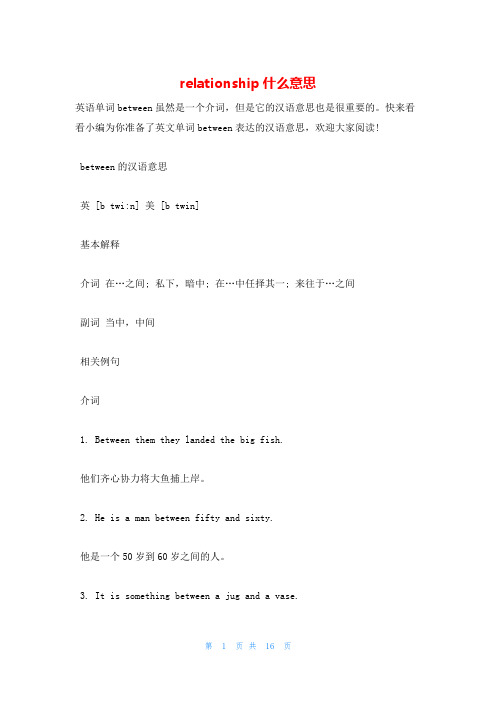
relationship什么意思英语单词between虽然是一个介词,但是它的汉语意思也是很重要的。
快来看看小编为你准备了英文单词between表达的汉语意思,欢迎大家阅读!between的汉语意思英 [b twi:n] 美 [b twin]基本解释介词在…之间; 私下,暗中; 在…中任择其一; 来往于…之间副词当中,中间相关例句介词1. Between them they landed the big fish.他们齐心协力将大鱼捕上岸。
2. He is a man between fifty and sixty.他是一个50岁到60岁之间的人。
3. It is something between a jug and a vase.这东西既象瓦罐又象花瓶。
4. Between us we managed to finish the job.我们俩合作设法把工作完成了。
5. There is a path between the house and the road.有条小路将房子与出路连接起来。
between的词典解释1. 在…之间;处于…中间If something is between two things or is in between them, it has one of the things on one side of it and the other thing on the other side.e.g. She left the table to stand between the two men...她离开桌子,站在了那两个男人之间。
e.g. Charlie crossed between the traffic to the far side of the street.查利从车流中间穿过,到了街对面。
2. 在(两地)之间(穿梭)If people or things travel between two places, they travel regularly from one place to the other and back again.e.g. I spent a lot of time in the early Eighties travelling between London and Bradford.八十年代初,我有很多时间穿梭于伦敦和布拉德福德之间。
- 1、下载文档前请自行甄别文档内容的完整性,平台不提供额外的编辑、内容补充、找答案等附加服务。
- 2、"仅部分预览"的文档,不可在线预览部分如存在完整性等问题,可反馈申请退款(可完整预览的文档不适用该条件!)。
- 3、如文档侵犯您的权益,请联系客服反馈,我们会尽快为您处理(人工客服工作时间:9:00-18:30)。
Present Relationship Between Marx’s Academic Thought andEngels’sAbstractEngels as Marx's close comrade in arms,revolutionary companion,has been along with Marx. They co-founded the theory of the proletarian revolution in pursuit of human liberation. Their relationship with academic once seen as one,with consistency. While in the west,about the academic relationship between them,constantly questioned and twisted by some scholars,thus forming a thought that considered Engels is Marx revisionism. The relationship between the Marx doctrine and Marc theory,the academic relation between Marx and Engels,the contact as well differences between them have constantly been stripped. Academia gradually made the theme highlighted in the process of questioning and arguing constantly in the west,it appeared “Marx and Engels on the arguments”,and its corresponding “Marx and Engels theory of consistency”. But in recent years,“on the difference between Marx and Engels”has been widely recognized. Here,it’s great significant for a betterunderstanding of the relationship between Marx’s academic ideas and Engels’s,a deeper understanding of their ideological content and the original text as well if we cared the academic relationship between Marx and Engels.Key words:Marx theory;Engels;arguments;differenceINTRODUCTIONSince the death of Marx,Engels took guidance of Labor movement banner,and continue to guide the establishment of the second international while collating and editing Marx's voluminous texts then continuously published these unpublished articles. Engels also wrote some famous masterpiece,such as Anti-Dühring,Dialectics of Nature,Ludwig Feuerbach and the End of German Classical Philosophy. He makes the Marxist philosophy systematic,but also met some challenges.1.MARX AND ENGELS ON THE ARGUMENTSSome western scholars think that Engels according to his own understanding of Marx's Mars,oriented Marxist mechanical,rigid,and according to his own preference obscured the Marxism. These objections gradually formed several waves that against Engels thought.First wave from the end of the 19th century to the beginning of the 20th century,the major objections from revisionism Bernstein and G Roach as the representative of Hegel’s historic ism. Bernstein thought that socialism is not a science,while Engels’s so-called dialectical materialism just belongs to pure theology. Starting from the western philosophy background of Marx,especially Marx’s inheritance of Hegel,they made an arbitrary comment that Engels is Marxist revisionist. The second wave from 20 to 30 s of the 20th century,triggered by lukacs and other famous people. Lukacs was the first one who in “History and Class Consciousness”from different aspects like dialectics,view of history,view of nature and epistemology pointed out Engels individual arguments and raised objections. Although Lukacs did not clearly elaborate that Marx and Engels are on the philosophical methodology of opposition. He mentioned that Engels’s inaccurate appropriation on dialectical method providing an effective way for the later “arguments” school. And there should not be ignored i s that Lukacs’s criticism is based on a certain basis of the needs of the political class struggle for the enforcement of certain political policy as the background.The third wave from 1950s to 1960s of the twentiethcentury,set off by the “western Marx school”. Founder of the West Marxism,Rubel,published in 1970,titled About”Engels as Marxism Founder the outline. He thought that Engelsin order to obtain full legitimacy of his vision of the “Marxism”,consciously ignore Marx some important manuscripts and some letters published,which hinders the reader’s understanding of Marx. It caused a sensation and controversy at the time. Norman,who belongs to the “Marx and Engels one the argument”advocated in his masterpiece The Tragic Deception:Marx was opposed to Engels”that the traditional Marxism is unable to be called Marxist but it is more appropriate that called the Engels doctrine. Because the mechanical materialism,positivism and social instrumental rationality and the Puritan occupational ethics from the traditional Marxism all originated from Engels. The book discusses the bifurcation of Marx and Engels theory comprehensively. So the main content can be summarized as two points:first,on the view of nature,Marx’s philosophy of nature is the dialectical naturalism,and Engels' natural philosophy is metaphysics of materialism. Marx not only applied the dialectical method into nature,but also further used in the interaction of human and nature. And Engels’s dialectic is the dialectics of nature. Second,on theview of history,Marx's view of history based on human centered. He believes that history developed along a multi line. While Engels is typical of economic determinism,he thinks economic power is the history of the subject. Obviously,Levin discussed in the book is too absolute and one-sided. The contrast of some views of Marx and Engels is rigid. But we need to pay more attention to Levin’s main purpose which is against the essence of Marx’s theory of practices as well as the former Soviet Union mechanical distortion of the second international Marxism and prevailing of Stalinism,reiterated that Marxist revolutionary and creative. Throughout the view of the above,we can see that Western Marxist scholars who belong to the “Opposition”,holding the analysis method,are biased to some extent. They use mainly “displacement method”,namely with Marx and Engels’a text in comparison with the text of a period to find their ideological differences. Obviously,this method of analysis is not the same argument in the range of ideological relations Engels and Marx. This comparison from a particular thought to go by the text of the situation to find the similarities and differences between the text,prone to argument arbitrariness. Inadequate this approach itself,but also directly led to the same hold“Opposition”of scholars to produce some of the points of conflict and confrontation between,and even themselves with their own views against each other.2.AGREEMENTS ON MARX AND ENGELSMainly in the second international and former Soviet Socialist scholars,including the mainstream of the Marxist scholars in our country. When Engels guided the Second international,widespread popular understanding between the European Social Democrats is “Marx and Engels Consistency”. Before and after the death of Engels,Kautsky as the representative of scholars questioned the wave of Engels as to counter,but most of them were based on the basis of the revolutionary tutors perceptual cognition and emotion,lacking of in-depth study of the text.While in China,the mainstream tone is consistent theory. For example,Professor Chang Kuiliang thinks that the difference between Marx and Engels is the basis of their cooperation,their thought,the experience,the focus of difference for the establishment of Marxist philosophy system played a complementary role in making the system more full,enrichment. Marx’s creative,critical,revolutionary critique of reality made the text more thoroughly,and also made thephilosophical revolution more convincing. Engels made a great contribution to the establishment of historical materialism and view of nature which are also undeniable.3.ON THE DIFFERENCE BETWEEN MARX AND ENGELSSince the beginning of the eighties of the 20th century,the Western Marxist scholars downplayed the struggle in the ideological field,and they are more inclined to back the text. They acknowledge the opposition on the basis of hard evidence,based on the present,based on the literature,and research Marx’s and Engels’s thoughts as well their relations. Then,mine the different points between them. Carver is the representative figure of this period,upholding the difference of therapeutics theory and text by researching methods to explore the differences between the two thoughts. His Marxand Engels Thought Contact book,from the early cooperation between Marx and Engels,talked that in the later time Engels misread the text from Marx. And after the death of Marx,Engels developed Marxism. From the perspective of the combination of logic and history,he profoundly analyzed the ideological relationship between Marx and Engels. But this time,the focus still lies in the difference between Marx and Engels. In his view,relationship problems are essentially a question oftherapeutics,and it depends on the commentators and text,dialogue between critics and audiences. Thus Carver established his own “on the difference between Marx and Engels”position:Acknowledge the similarities of Marx and Engels,finding and pointing out what is the difference in a different context and avoid mechanical interpretation. At the same time,how to reveal the true relationship between Marx and Engels is a continuous exploration and verification process,and we can not give only an answer. What is more?We should see that the Carver's thought shows that the ideological color watered down so that the relationship between Marx and Engels can be dealt with more objective. The domestic scholar He Songhua thinks that there is the positive significance if Marx and Engels’s academic thoughts are restored. If we see the Marx and Engels as a consistent idea,it is tantamount to make the myth. He believes that distinction in academic is (a)a “transcendental”and “empirical”research vision from the perspective of difference:Marx about social ideal from the sublimation of private property “to”where realm of freedom is the sphere of material production and the social reality of the other side of the world “all possessed transcendental. While Engels tend to construct the philosophy of science,which hasthe characteristic of realism. He thinks philosophy is more abstract and empirical science of learning depends on experience. (b)The difference between “the existence determines consciousness”and “the material determines the spirit”. Engels believed that material decides the spirit and concept of material are from the sum of the abstract. This view is separated from the substance of the perceptual existence and practice. Which Contrary to Marx “existence determines consciousness”. (c)The difference between the capital truth and the lowercase truth. In Marx there,the truth is rather narrow provisions than the recovery of the true history and human nature. And in Engels’s view of truth,their truth belongs to the framework of epistemology which in line with the correspongdence theory. (d)The difference between “other side of the realm of freedom”and “this side of the realm free”. Marx thinks the free kingdom is through the sublimation of alienation,with metaphysical nature of man's spontaneous elimination of ultimate to achieve the social goal which is metaphysics. Engels’s freedom is based on nature and the social law. (e)The difference in individuality. Marx,who compared with Engels,had more romantic patriotism on the background of scientific knowledge and social experience. Theabove points in the study of Marx and Engels ideological differences can not be ignored.Another typical representative on the theory on the difference between Marx and Engels is Professor Yu Wujin. Marx and Engels,he argues,largely consistent does not mean there is no difference between their philosophical thought. He boils the difference between Marx and Engels down to four points. (a)On the understanding of philosophy research as the starting point. Marx in the “These on Feuerbach”clearly pointed out practice is his philosophical starting point,and Marx's concept of practice is the revolutionary struggle. While Engels emphasized that the practice is experimental and industrial. (b)On the development trend in philosophy. For Marx,man of practice,humanitarian,the sublimation of alienation and alienation,people’s freedom and liberation will increasingly become the theme of the philosophy of the future. Engels argues that the trend of the development of the philosophy is not around the human practice activity. It will naturally lead to the pure thinking activity. (c)On the understanding of the nature,Marx always put nature understood as a social category,it emphasizes that people through the medium of social practiceis related to nature. Human beings exist in humanized nature. Engels was the view is that we have to consider nature's own movement. (d)On the understanding of freedom,Marx was from the perspective of the theory of ontology,namely between people survival relationship starting to think about the free problem. Engels is from the etymological perspective,namely knowledge on the relationship between the nature of human beings to think about the problem of freedom. Here,the author points out their different understanding of the same subject in different writings. Some are convincing.4.EVALUATION ON IDEOLOGICAL RELATIONS OF MARX AND ENGELS4.1 Marx Was Inspired by EngelsAs we all know,Marx was affected by Engels The Outline of National Economics Criticism turned from the criticism on “copy”to “original criticism”. During the period of the German and French yearbook,due to touch the material benefits problem,shacked the his idealistic views about the state and the law. He believes that the anatomy of civil society should seek from political economics. But after the political economic research on Hess and Engels directly promoted Marx began the study of economics. Especially Engels in the criticismof national economic outline “(hereinafter referred to as the”program “)for the writing of Marx's”economic and Philosophic Manuscripts in 1844 “opened the field of vision. Engels in the “outline”reviews the bourgeoisie from mercantilism to physiography and the formation of the political economics represented by Adam Smith,though it is a progressive system,there also are defects. Emphasis on the foundation of the national economics---private ownership of the hypocritical sex which the cause of free competition and monopoly for increasing wealth,formed a phenomenon that human is attached under capitalism. He thinks the existing economic relations must be criticized and changed from the system of its own contradictions. And Marx was greatly inspired by the idea,which makes his alienation view from the political alienation into the economic field. He put forward “alienation labor”theory in “Paris manuscripts”. Marx also from the point on the basis of private ownership,saw the opposite extreme between workers and capitalists. And workers’labor aliened instead of objectification. He believed that only eliminate private ownership and eliminate money for people in order to achieve the elimination of alienation of human beings. Here,Marx,from Engels’s providing premise,setting outcontradictions and found the alienation of human nature aswell the ways that how to eliminate it,inspired by Engels and beyond the vision of Engels.4.2 Engels and Marx Co-Founded the Historical Materialism and the Communism TheoryMarx and Engels first cooperation is to create the “holy family”. They established the foundation and the birthplace of the history- reality of material production,for the first time. It linked history to material production,philosophy to the masses,reaching a new height. And on the questions about the nature of people,from the “economic and philosophical manuscripts of 1844”with Feuerbach humanism tendency of abstract “class”transition to a specific symbol of the “realistic individual”of the masses,contains the historical materialism point of view. And the second cooperation -- the “German Ideology”marks the formal establishment of the materialist conception of history,marking Marx completely liquidated the philosophical beliefs. The combination of the detailed division of labor under different social conditions,the condition of social interactions,the historical development of private ownership system of historical materialism:effect on the decision of the social and historical material production way,the economic base determines the superstructure,social being determines social consciousness. Detailed with different social status under the division of labor,communication,the private ownership of the development history,then proposed system of materialist conception of history:Material production determines effect on social history,and the economic basis determines superstructure,and social existence determines social consciousness. However,in the process of establishing system of historical materialism,most of the theoretical thoughts originated from Marx,but Engels' achievement cannot be ignored. first of all,Engels was copying and transcribing the manuscript,and a considerable number of the original manuscript he had to modify,supply. Secondly,in thinking about the “division of labor”,Marx focused “division of labor and history”and Engels focused more on the “family,private property and the state and revolution”. Engels was from the gender division of labor,the family division of labor,the ruling class,the Communist revolution,for the abolition of private ownership and the division of labor,thinking about the division of labor,emphasized the importance of the proletarian revolution. While Marx from the perspective of the combination of history,on the basis of theproductivity development,lead the universal association and the world market. Moreover,complement enriched historical materialism. And the Communist Party Declaration,which was the third time Marx and Engels cooperated with,as the symbol of Marx and Engels created new world view,becoming the guide for liberation struggle of the working class and powerful ideological weapon. It emphasized that the bourgeoisie will perish in the struggle,and the proletariat will obtain the world. Greatly inspiring the world proletariat,and created a new era. Among them,Engels’s contribution can not be denied.4.3 Engels’s Maintenance and Supplement of Marx Theory to Marx's TheoryEngels wrote down Anti Duhring in order to counterattack the vogue opportunism from German workers party and questioned Marx's thoughts of Du Lin wrong ideas. And write down. Engels criticized the Duhring erroneous ideas. At the same time,this paper expounded the epistemology and the theory of truth from the theory of materialism. The writing of Dialectics of Nature was for the study of the system to summarize the achievements of the natural science,in order not to delay Marx’s Das Kapital text and independently tocritique in idealism and metaphysics thought in the field of natural science. On the other hand,it also greatly improved the system of Marxist philosophy and expanded Marxist philosophy research field. Marx’s vast unfinished “das kapital”which was published by Engels and Engels also made efforts to sort out. In his later years,Engels had been wrote many letters in order to the spread of the theory of Marxist historical materialism. Meanwhile,explained,clarifed with the people who has the misunderstanding of it. It committed to achievethe Marxist theory of systematic and systematization.CONCLUSIONEngels in the Ludwig Feuerbach And the End of the German Classical Philosophy,sincerely said:“please allow me make a little personal specification here. These day’s people more than one time mentioned that I participated in the formulation of this theory,so I have to say a few words here,to clarify the problem. I can not deny the fact that Marx and I have worked together for 40 years,and this before this period,I independently participated in the founding of this theory to some extent,especially in the exposition of this theory. However,most of the basic guiding ideology (especially in the field of economics and history),especially to the guidingideology of the explicit expression,all belong to Marx. What I provided,without me Marx also can do it,except for up to a few specific areas. As for Marx,but I can’t do. Marx was a genius,but we are masters at most. Without Marx,our theory far won’t be like this. So,this theory in his name for granted.”Here,Engels called Marx as genius,but her modesty to say they are masters at most. And he can be a “second violin”. Thus we can see his noble personality quality. At the same time,we should not forget that Engels’s historical achievement in Marx theory. REFERENCESCarver,T. (2006). Marx and Engels or Engels to Marx. Jianghai Academic Journal,6.Chang,K. L. (1991). The contribution of Engels in the process of the new philosophy founded by Marx. Modern Philosophy.Chang,M. (2008). Looking back on the relationship between Marx and Engels theory and the correct understanding of Marx and Engels. Scientific and Technological Information,8.Chen,X. D. (2010). Towards the depths of history. Beijing:Chinese People’s University Press.Chen,Y. Z. (2012). Understanding Marx. Beijing:Guangming Daily PressDong,Q. Q. (2008). A review of “Marx and Engels difference theory”. Guangxi Social Science,(3).He,S. H. (2004). On the difference between Marx’s philosophy and Engels’s. Dongyue Tribune.Marx,K,F.,& Engels.,F,V. (1995). Selections (anthologies)of Marx and Engels Being:People’s Publishing House.Yu,W. J. (2004). On the difference between Marx’s philosophy and Engels’s. Jiangsu Social Sciences.。
